| |
Historical
Background
The Tswana people entered South
Africa from the north in three migrations between the
years 1300 and 1600. The first of these migrations brought
the Kgalagadi people, who were later followed by the
ancestors of the present Rolong and Thlaping tribes.
The third group settled in the south-western part of
what is today the Transvaal province of the Republic
of South Africa.
This group later divided into smaller groups, the most
important of these being the Hurutse, Kwena and Kgatla
tribes. It is estimated that
the Tswana migrants had reached the Eastern part of
the present Bophuthatswana by the year 1600. During
the ensuing two centuries many tribes became subdivided
into smaller tribes. The Rolong split up into the
Thlaping and other groups while the Hurutse divided
into the Manyana, Thlaro. Khurutse and other smaller
tribes.
The Kgatla tribes split into groups such as the Mosethla,
Kgafela, Motsha and others. Another subdivision of
the early Hurutse people, the Kwena, later split into
the Fokeng, Mogopa, Modimosana and Phalane sections.
During the troubled years between 1820 and 1840 the
Tswana tribes were attacked and routed by warriors
of the Matabele chief Mzilikazi and other aggressors.
After the advent of the White man the process of fragmentation
of the Tswana people was gradually superseded by a
process of amalgamation.
In 1977 75 autonomous tribes comprise the Tswana nation
of Bophuthatswana and the population totalled 2,100,000
while the de facto population was estimated at 1,036,000.
Political development
The tribal wars that had disrupted the lives of the
Tswana people for so many years came to an end when
the Whites, who moved into the Transvaal during the
middle of the previous century, intervened. The various
Tswana tribes and groups then gradually moved back to
the areas they had originally occupied. They were unified
on 21 April 1961 when the Tswana Territorial Authority
was established. The members of the Territorial Authority
were nominated by regional authorities that in turn,
were comprised of members nominated by the various tribal
and community authorities established in terms of the
Bantu Authorities Act of 1951.
Continued
in next column |
|
The Tswana
Territorial Authority became a legislative assembly
on 30 April 1970 and on 1 June 1972 the Tswana homeland
became known as Bophuthatswana when the State President
of South Africa declared its twelve districts a Self-governing
territory within the borders of the Republic of South
Africa. The Legislative Assembly adopted a constitution
for Bophuthatswana that was drafted by the Tswana
people to suit their particular needs.
The first general election was
held on 4 October 1972.
During its session of November 1975 the Legislative
Assembly gave Chief Minister Mangope a mandate to
negotiate Bophuthatswana’s Independence with
the South African Government. A joint cabinet committee
and a seven-member working committee were then established
to prepare for Bophuthatswana’s Independence
on 6 December 1977.
Geographical and physical features
The land-consolidation proposals adopted by the South
African Parliament in 1975 provide for Bophuthatswana
to consist of six separate blocks. Except for Thaba
Nchu. which is located in the southern part of the
present Orange Free State, these areas are situated
in the Western Transvaal and the North-western Cape
Province. The country has three
river catchment areas - those of the Molopo, Limpopo
and Vaal Rivers. The Molopo catchment area is characterized
by dry, sand-filled river-beds. The tributaries of
the Limpopo River drain the northern districts while
the Harts River and its tributary the Dry Harts River
mainly the Taung district. On account of its semi-arid
Bushveld and grass-veld, Bophuthatswana is specially
suited to cattle farming. The country is also rich
in mineral deposits, which augurs very well for its
future.
Industry
The country’s major industrial growth
point is situated at Babelegi some 50 km north of
Pretoria. Industries have also been established at
Selosesha (Thaba Nchu), Pokeng and Montshiwa.At Babelegi
85 factories have already been established on an area
of 176 ha. All available sites have been allocated
to industrialists and 100 factories ought to be in
full production at the end of 1977.
Source Bophuthatswana Brochure published
by INTERSAPA (1979)
|
|
6 December
1977 - Independence
|
| |
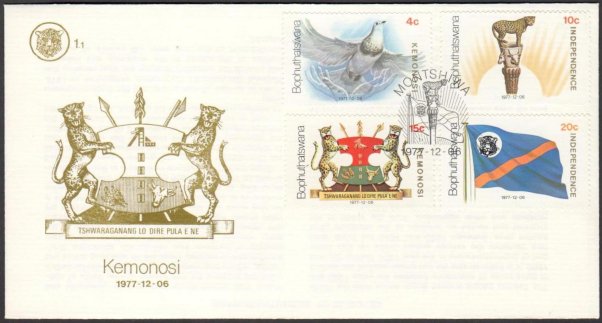 First Day Cover
First Day Cover
|
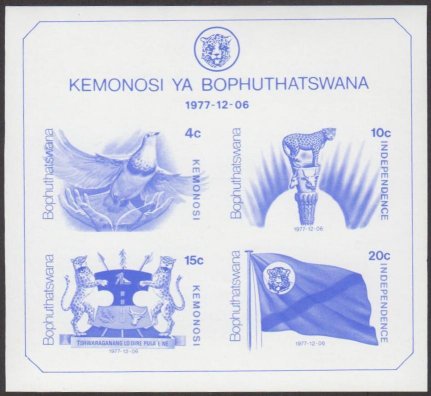 Non Postal Blue-print gummed
MS
Non Postal Blue-print gummed
MS |
.jpg) Collectors Sheet (Folded)
Collectors Sheet (Folded)
|
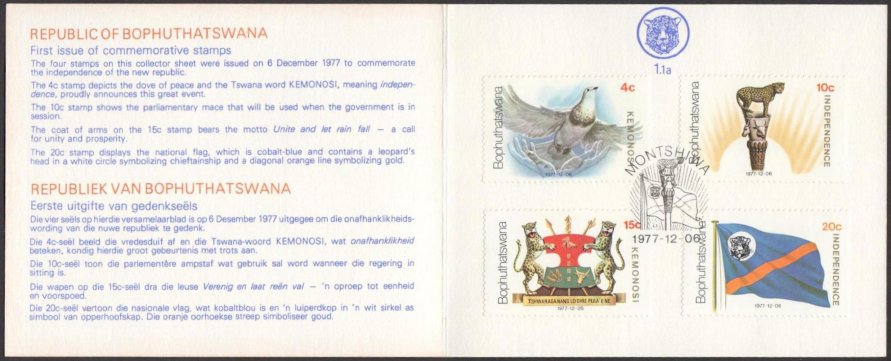 Collectors Sheet (Small Folder)
opened up
Collectors Sheet (Small Folder)
opened up |
| 6
December 1977 - First Definitives
The issue was
announced in the December 1977 edition of
The South African Philatelist
and rerceived further attention
in the February 1978 SAP
Postal Stationery was also
issued, Postcards (3c Inland)
a Registered envelope plus Aerogrammes (4c
& 10c) |
|
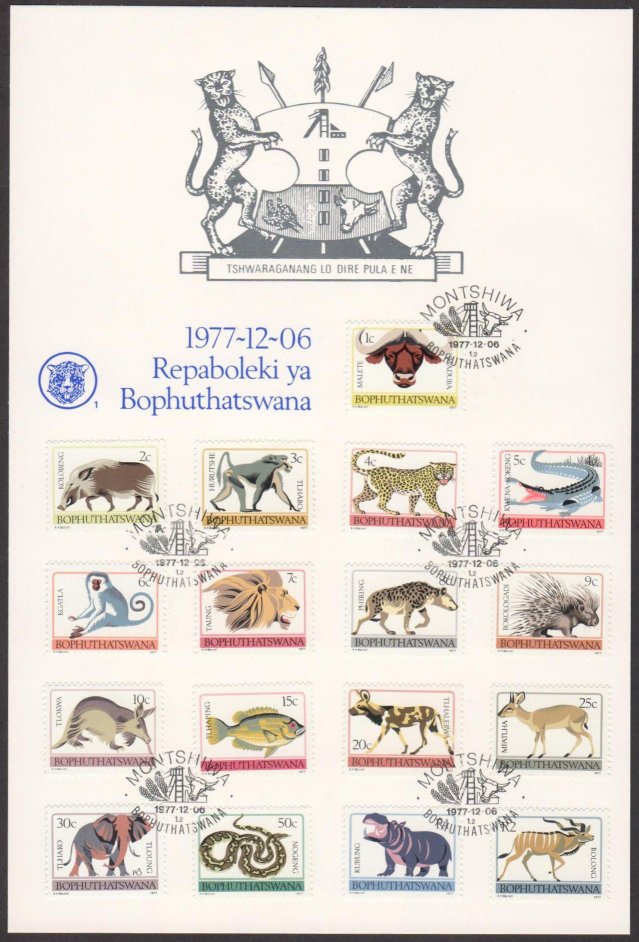 First Day of Issue Card
with details of the Tswana Totems depicted on the
stamps
First Day of Issue Card
with details of the Tswana Totems depicted on the
stamps
The 4c value is the National Emblem of Bophuthatswana |
|
| |
|
|
Artist/Designer
A.H. Barrnett
Printed in Panes of 25
Producing Cylinder strips of 5 |
| |
7
April 1978
World
Hypertension Month |
|
|
| Artist/Designer
- Attributed to A.H. Barrnett
|
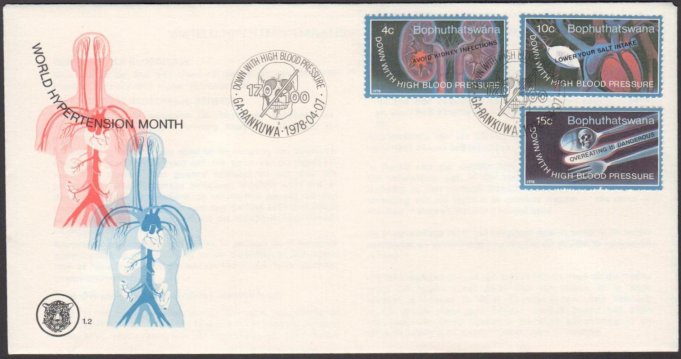 First Day Cover
First Day Cover
|
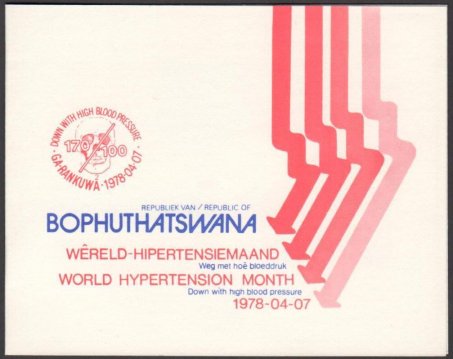 Collectors Sheet (Folded)
Collectors Sheet (Folded)
|
| 12
July 1978 - Road Safety |
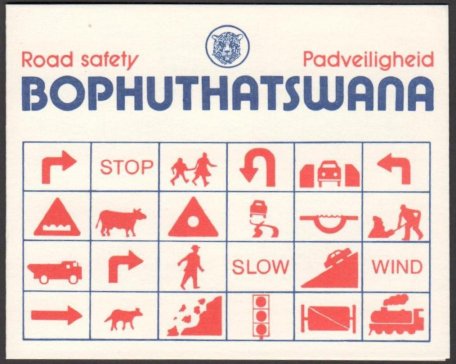 Collectors Sheet (Folded)
Collectors Sheet (Folded)
|
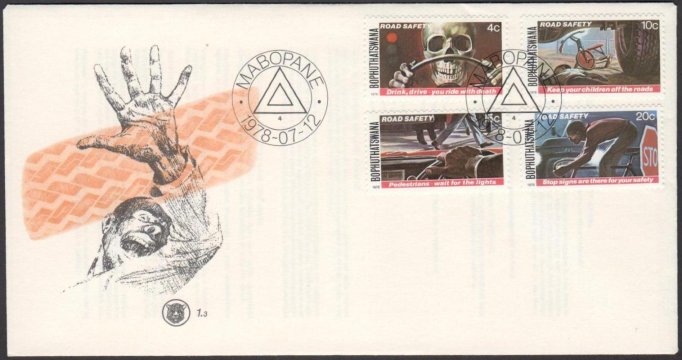 First Day Cover
First Day Cover
|
| 3
October 1978 - Taung Stone Works |
| Artist/Designer
A.H. Barrnett |
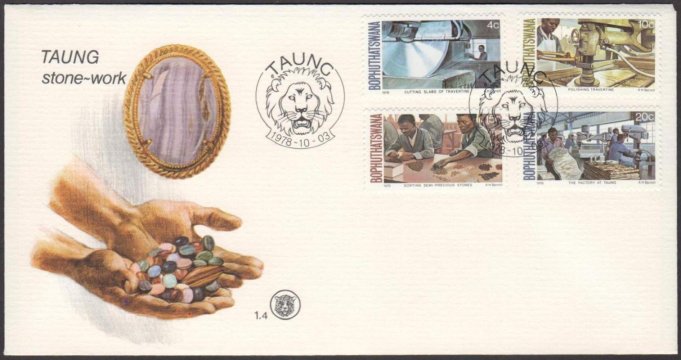 First Day Cover
First Day Cover
|
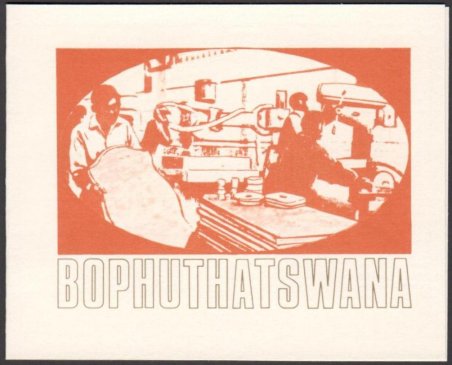 Collectors Sheet (Folded)
Collectors Sheet (Folded)
|
| |
1
December 1978
75th Anniversary of
Powered Flight |
|
| Artist/Designer
A.H. Barrnett |
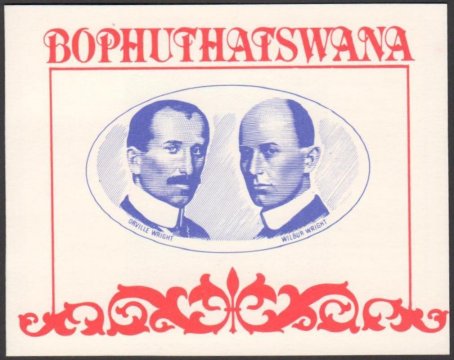 Collectors Sheet (Folded)
Collectors Sheet (Folded)
|
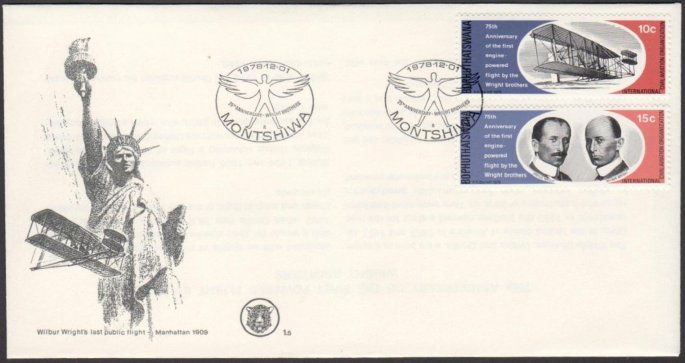 First Day Cover
First Day Cover
|
| 6
December 1978
First Independence Anniversary
| |
President
Mangope was described as a Stateman
with a far-sighted vision
and a skilled negotiator
who led the people of Bophuthatswana to Independence
on
6 December 1977
Artist/Designer
Attributed
to A.H. Barrnett,
it is likely that the stamp design is photographic.
The illustration on the FDC envelope is probably
by Barrnett. |
| |
|
.jpg) President Lucas
Mangope
President Lucas
Mangope
.jpg)
|
| Artist/Designer
A.H. Barrnett |
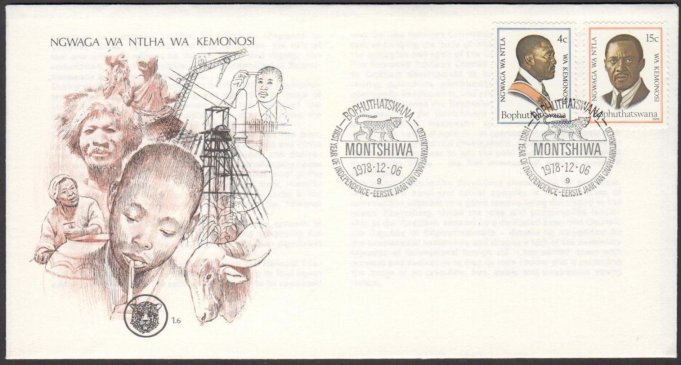 First Day Cover
First Day Cover
|
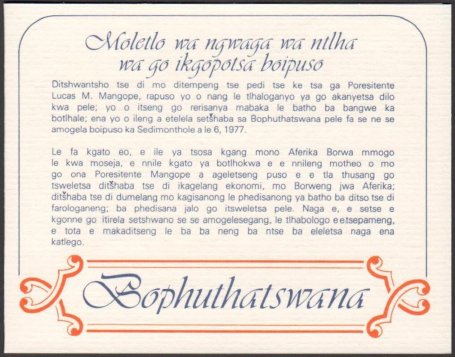 Collectors
Sheet (Folded) Collectors
Sheet (Folded) |
| 28
February 1979 - Production of Sorghum Beer |
| Artist/Designer
A.H. Barrnett |
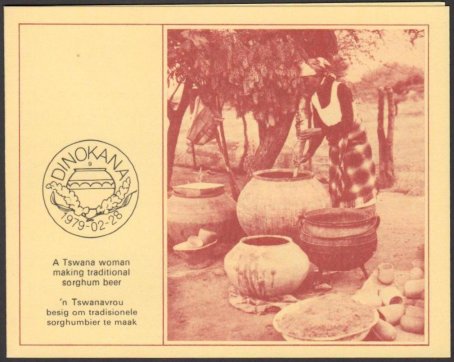 Collectors Sheet (Folded)
Collectors Sheet (Folded)
|
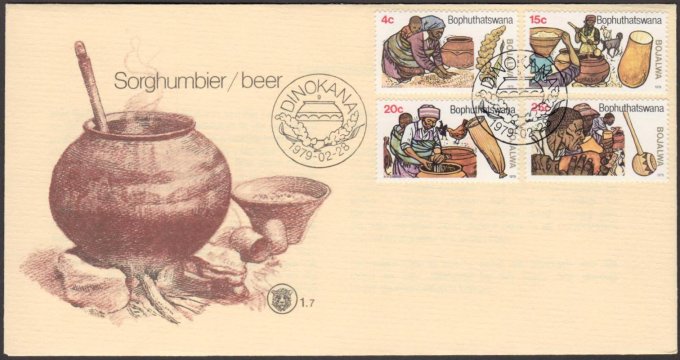 First Day Cover
First Day Cover
|
|
2 June 1979
World Heavy-weight
Title Fight
 Kallie Knoetze (SA) - John
Tate (USA)
Kallie Knoetze (SA) - John
Tate (USA) |
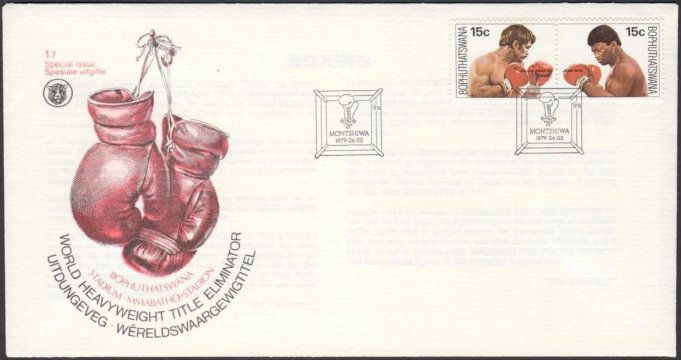 First Day Cover
First Day Cover
|
| |
Initial
World Heavy-weight Boxing matches in Africa
The first world heavy-weight title fight to be held
on the African continent took place in Kinshasa, Zaire,
on 30 October 1974, when Muhammed Ali regained the title
from George Foreman. Five years later a second championship
fight was held in Pretoria, South Africa. when Gerrie
Coetzee met John Tate for the vacant WBA title. Coetzee
lost the match in the 15th (last round) on points.
Kallie Knoetze (SA)
vs John Tate (USA)
Knoetze
(Born 1953 in Roodepoort) faced
Tate at the Independence Stadium in Mmabatho,
Bophuthatswana and lost in the
12th Round with a TKO.
The
above issue marks the occassion of the Knoetze vs Tate
fight.
|
|
Gerrie
Coetzee (SA) vs Mike Weaver (USA)
When Gerrie Coetzee (Born 1955) stepped into
the ring at Sun City, Bophuthatswana on 25
October 1980 to fight Mike Weaver
for the World Boxing Association’s heavy-weight
title it was only the third time in the long history
of this division that a world heavy-weight championship
fight was held in Africa.
A special stadium was built at Sun
City (Superbowl) to accommodate a crowd of approximately
16000, and millions more around the world watched
the fight live via television. Coetzee lost in the
13th out of 15 Rounds with a TKO.
Coetzee's boxing career included 40 fights, 33 wins,
6 lost and one draw. |
|
|
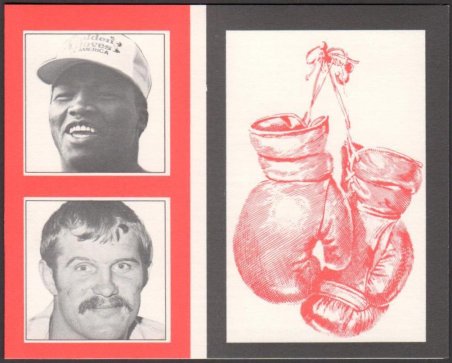 Collectors Sheet (Folded)
Collectors Sheet (Folded)
|
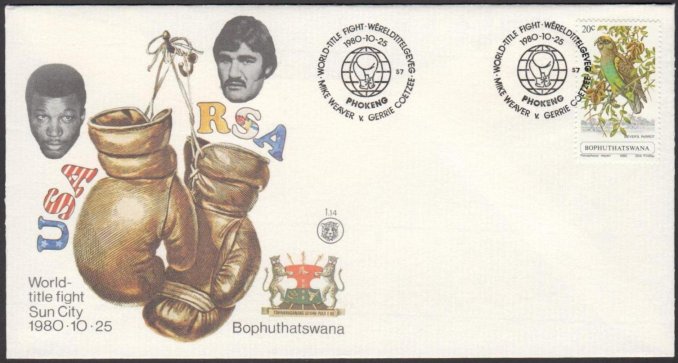 Commemrative Cover
Commemrative Cover
|
| 7
June 1979 - Year of the Child |
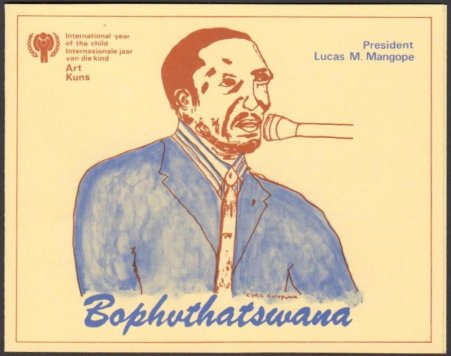 Collectors Sheet (Folded)
Collectors Sheet (Folded)
|
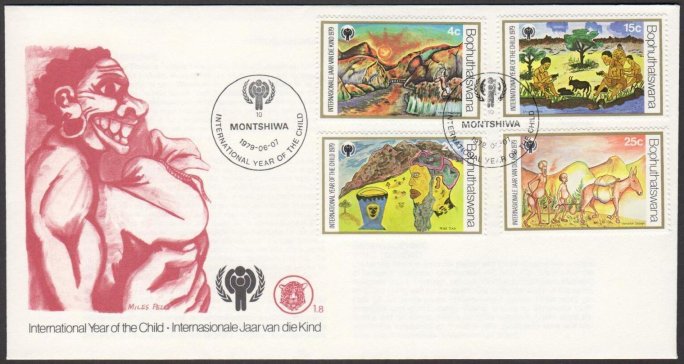 First Day Cover
First Day Cover
|
| 15
August 1979 - Platinum |
| Artist/Designer
Bernard Sargent |
| |
Mining
in Bophuthatswana
Bophuthatswana is rich in mineral deposits that were
being exploited at 36 operating mines. The most important
deposits are platinum, iron ore, manganese, sandstone,
limestone, granite, chrome, fluorspar, nickel, vanadium,
salt, copper and asbestos.
In the late 1970’s, five platinum mines provided
employment for 57000 workers. One of the world’s
largest platinum mines, the Impala Mine, operates
in the Mankwe and Bafokeng districts. At two other
platinum mines this valuable mineral is being mined
partly on tribal land and partly on White-owned land
in the Rustenburg district.
|
|
Vanadium
is mined at the Ucar Mine in the Odi district asbestos
in the Ganyesa and Thlaping- Thlaro districts and
chrome in the vicinity of Rustenburg and Marico. There
are also six granite quarries in Bophuthatswana. Three
limestone mines are located in the Taung district.
Other mines produce fluorspar in the Odi district
and manganese in Lehurutse. Sandstone reserves are
present in the country’s districts north of
Pretoria.
Since 1969 the Bantu Mining Corporation
has spent R527,740 on exploration in Bophuthatswana
while the cost of exploration activities carried out
by private enterprise amounted to R1,934,214 during
the period 1972 to 1977. |
|
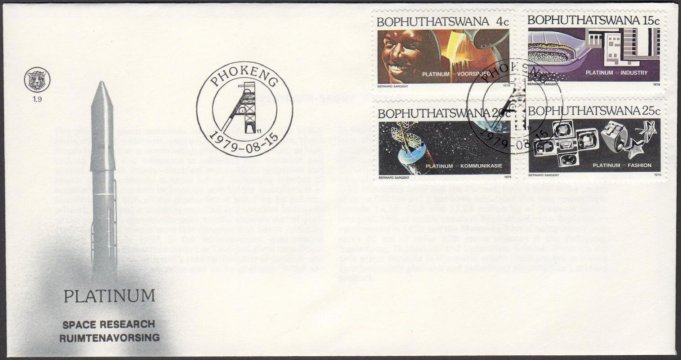 First Day Cover
First Day Cover
|
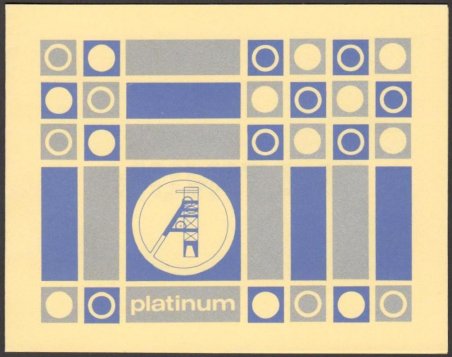 Collectors Sheet (Folded)
Collectors Sheet (Folded)
|
| 25
October 1979 - Agriculture |
| Artist/Designer
A.H. Barrnett |
| |
Agriculture
in Bophuthatswana
As a result of the relatively low rainfall experienced
in Bophuthatswana, the country’s main agricultural
activity is stock farming, especially cattle farming.
Although the turnover of cattle is higher than in
most other Black states in Southern Africa, agricultural
experts are convinced that the gross value of the
country’s cattle can be considerably increased
by better farming methods.
Bophuthatswana is partially situated in the most prosperous
maize-farming area of Southern Africa. In 1974 the
dry-land crops produced by Tswana
farmers totalled 34,500 tons of maize on 38,800 hectares,
7800 tons of grain sorghum on 13400 hectares and 3200
tons of wheat on 13100 hectares.
|
|
The Lesedi
Irrigation Scheme in the Taung district caters for individual
farmers who grow wheat, maize, peas, groundnuts, lucerne
and cotton under ideal conditions. Co-operative agricultural
development projects were initiated and examples of
successful ventures of this nature are cattle marketing,
industrial plant production, a fish-breeding scheme
and a co-operative dairy farm that provides Mabopane
and other large towns with fresh milk.
Sisal is the most important industrial crop produced
in Bophuthatswana. About 1600 hectares are under cultivation
and the fibre is processed in the country. |
|
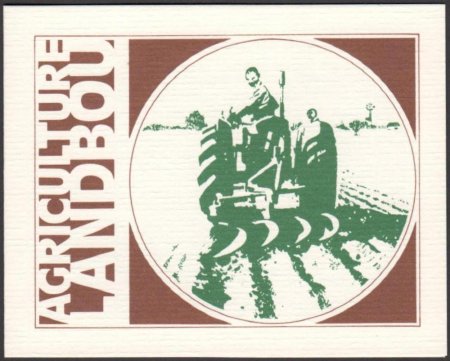 Collectors Sheet (Folded)
Collectors Sheet (Folded)
|
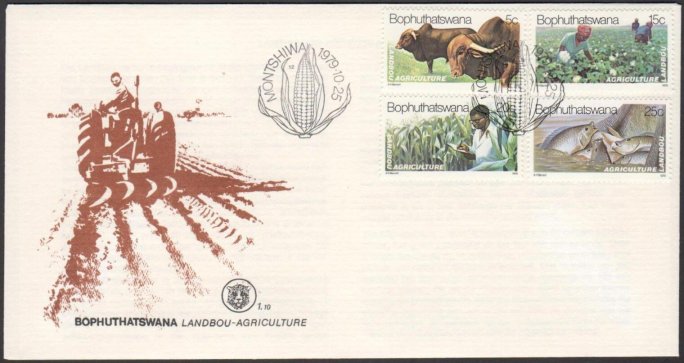 First Day Cover
First Day Cover
|
5
March 1980
Anti Smoking Campaign
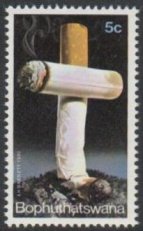
|
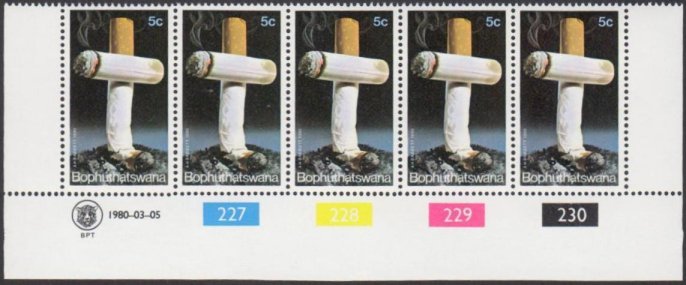 Commemorates
the first Anti-smoking act in Southern Africa in June
1979
Commemorates
the first Anti-smoking act in Southern Africa in June
1979 |
| Artist/Designer
A.H. Barrnett |
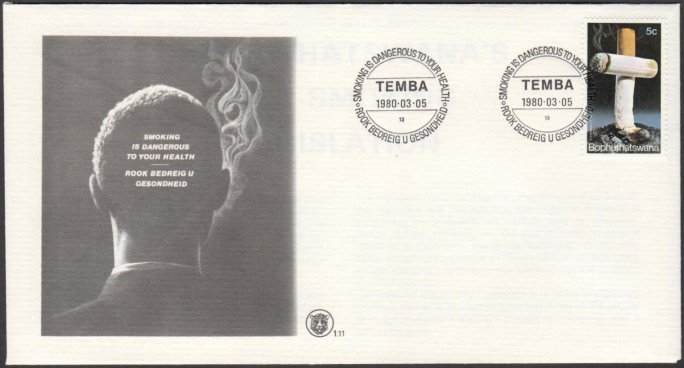 First Day Cover
First Day Cover
|
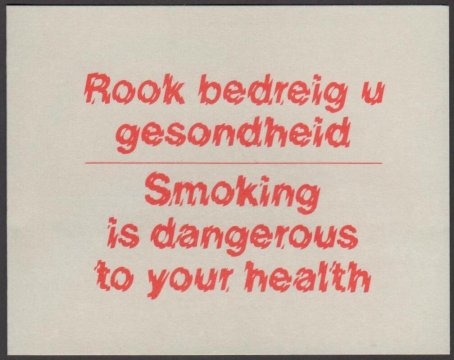 Collectors Sheet (Folded)
Collectors Sheet (Folded)
|
| |
|
4
June 1980
Edible Wild Fruit |
|
|
| Artist/Designer
Dick Findlay |
| |
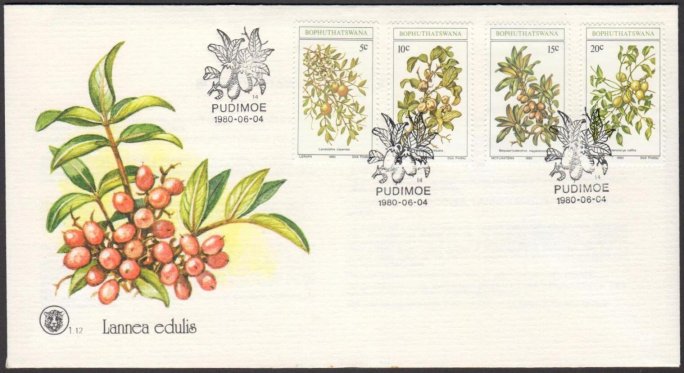 Above - First Day Cover
Above - First Day Cover
Left - Collectors Sheet (Folded)
|
| Artist/Designer
Dick Findlay |
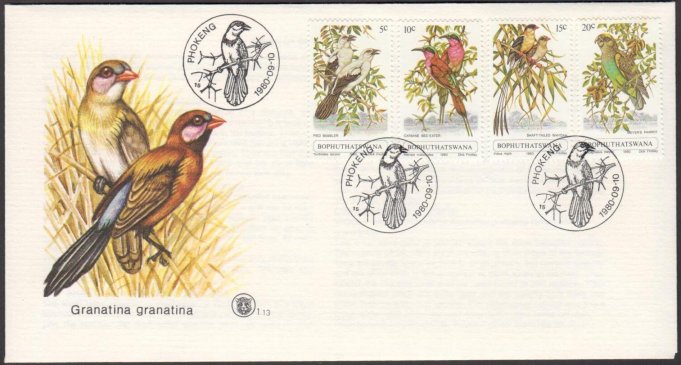 First Day Cover
First Day Cover
|
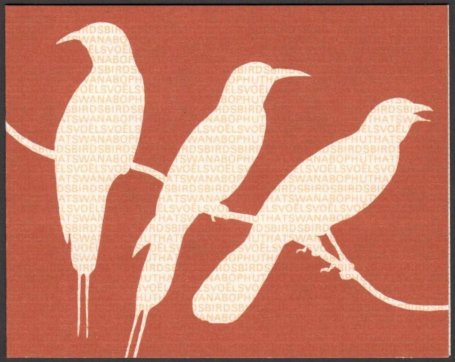 Collectors Sheet (Folded)
Collectors Sheet (Folded)
|
| 6
December 1980 - Tourism |
| Artist/Designer
Pieter Roos and G. Mynhardt |
| |
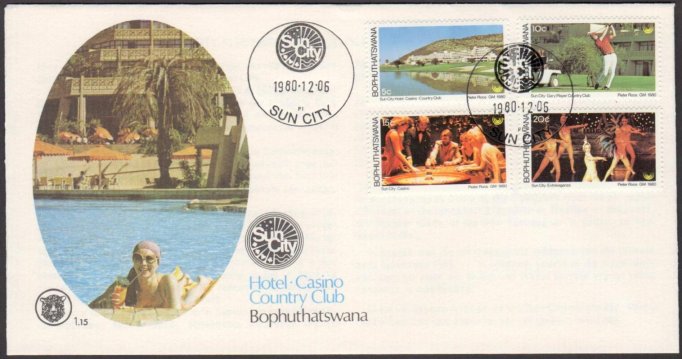 Above - First Day Cover
Above - First Day Cover
Left - Collectors Sheet (Folded)
|
|
30
January 1981
International Disabled Year
Artist/Designer Hein Botha |
|
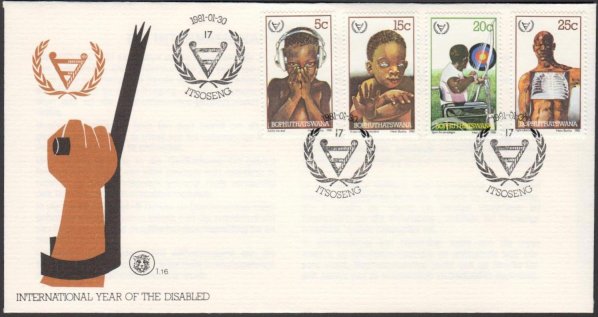 First Day Cover
First Day Cover |
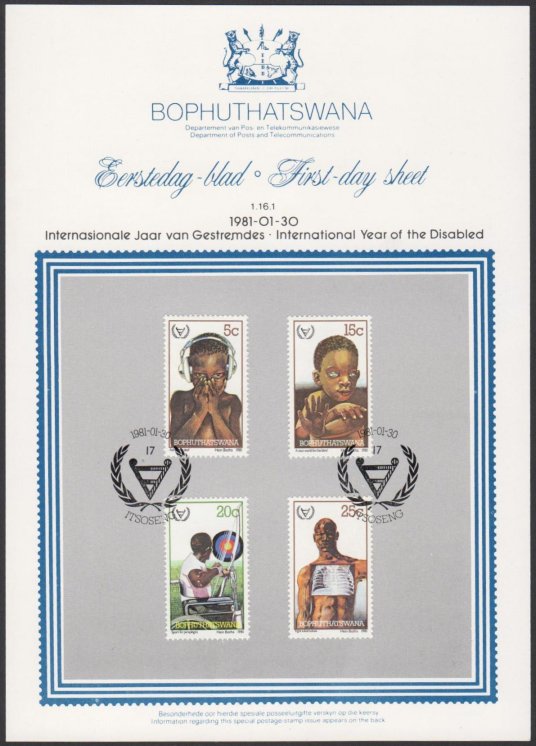 Collectors Sheet
Collectors Sheet
|
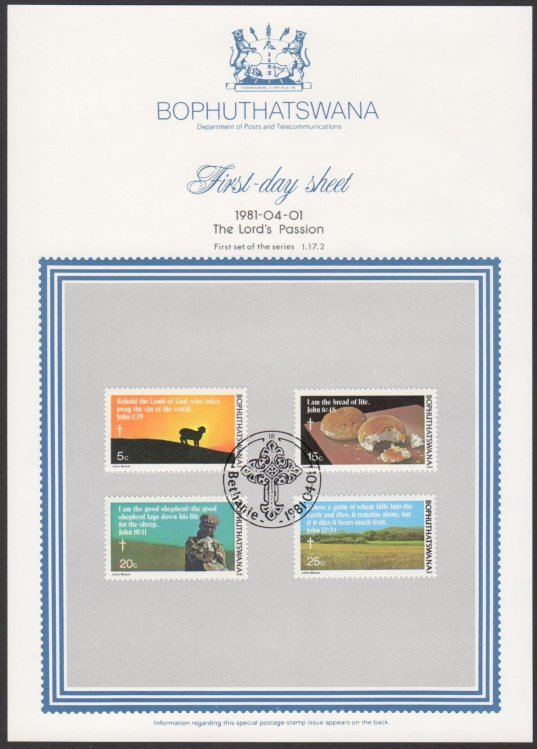 Collectors Sheet
Collectors Sheet
|
Artist/Designer
John Meyer
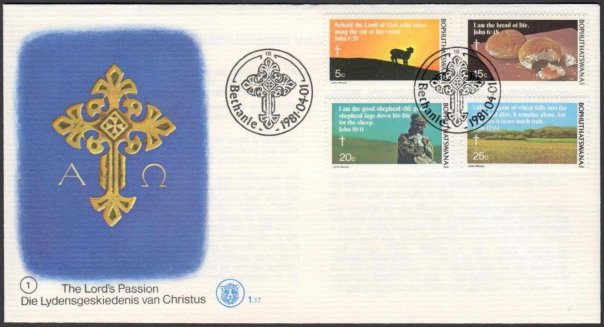 First Day Cover
First Day Cover
|
| 1
April 1981
Easter Stamps (1st Series)
|
|
|
31
July 1981
History of the Telephone (1st Series)
Artist/Designer John Hoekstra |
|
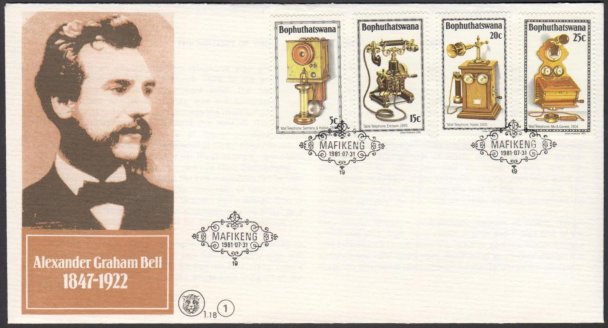 First Day Cover
First Day Cover
|
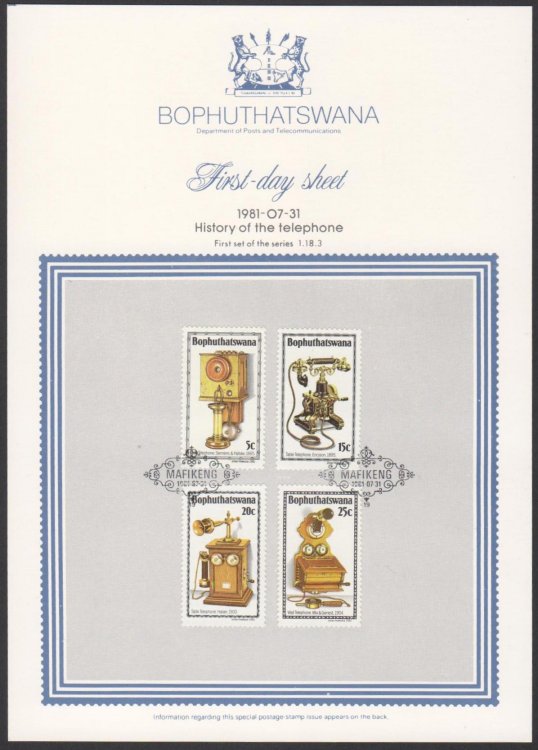 Collectors Sheet
Collectors Sheet
|
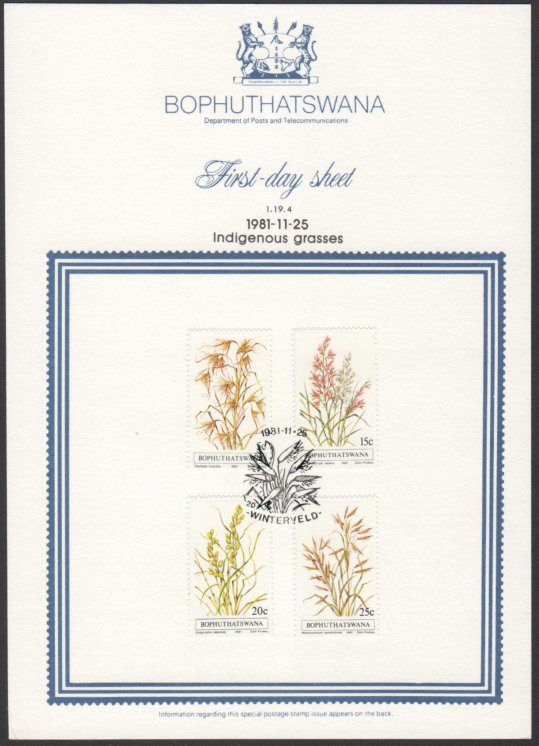 Collectors Sheet
Collectors Sheet
|
| Artist/Designer
Dick Findlay |
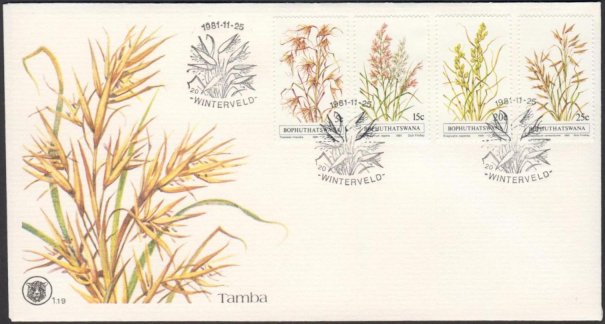 First Day Cover
First Day Cover
|
|
25
November 1981
Indigenous Grasses (1st Series)
Artist/Designer Dick Findlay |
|
|
29
January 1982
75th Anniversary of Boy Scouts
Artist/Designer Sheila Nowers |
|
 First Day Cover
First Day Cover
|
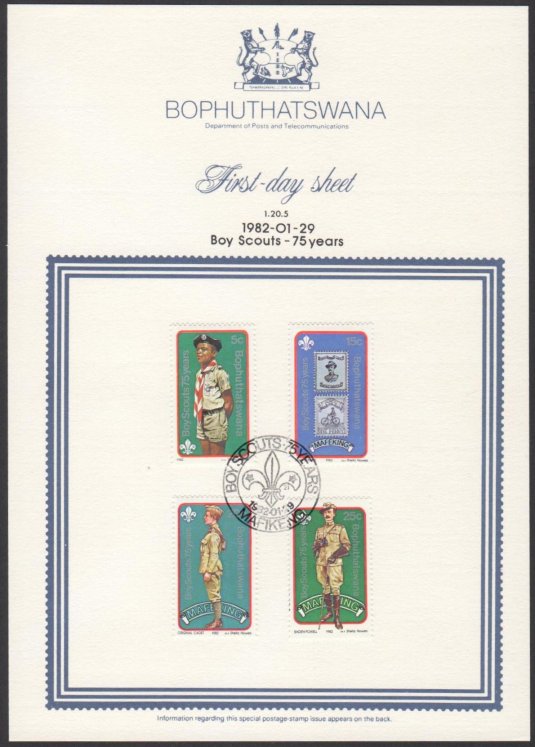 Collectors Sheet
Collectors Sheet
|
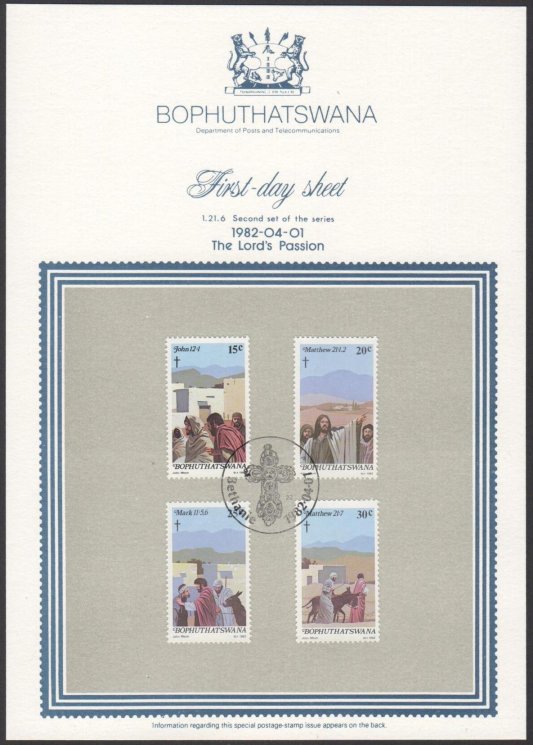 Collectors Sheet
Collectors Sheet
|
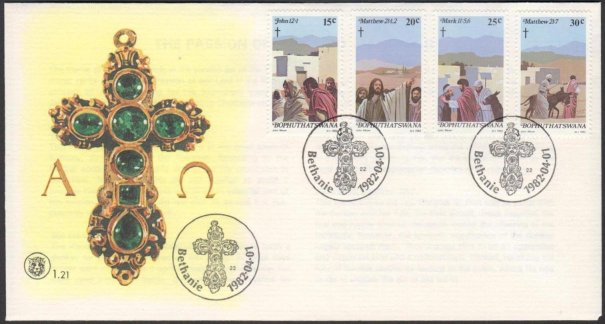 First Day Cover
First Day Cover
|
|
1
April 1982
Easter Stamps (2nd Series)
Artist/Designer John Meyer
|
|
| Artist/Designer
John Hoekstra |
|
|
History
of the Telephone
(2nd Series) |
|
|
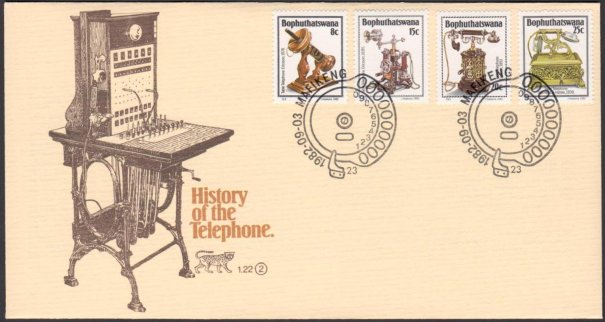 First Day Cover
First Day Cover
|
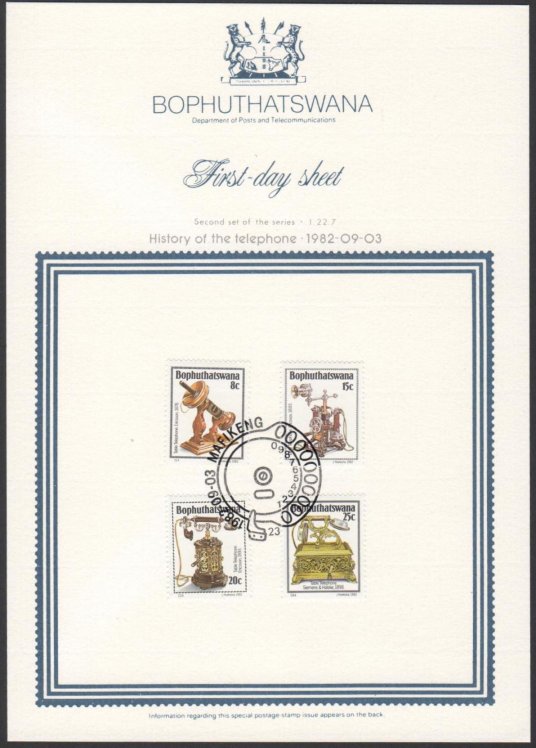 Collectors Sheet
Collectors Sheet
|
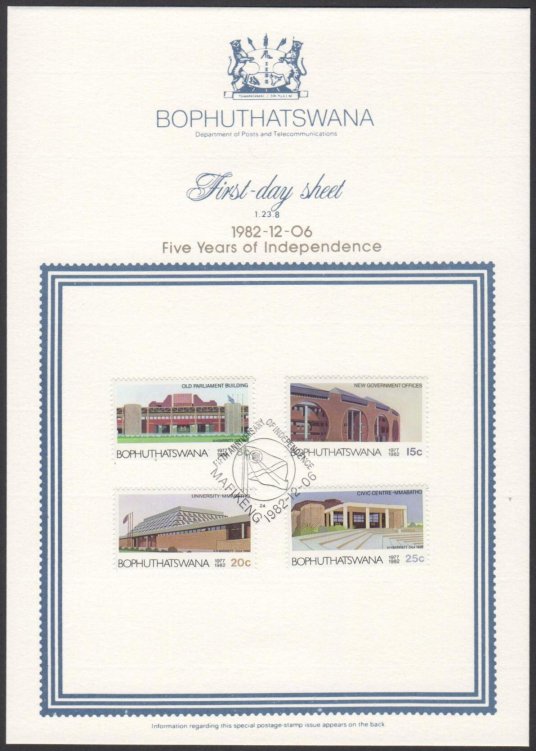 Collectors Sheet
Collectors Sheet
|
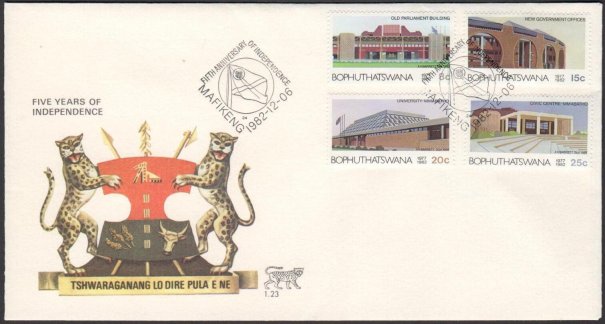 First Day Cover
First Day Cover
|
| 6
December 1982
5th Independence Anniversary
Artist/Designer A.H. Barrnett |
|
| 5
January 1983
Pilansberg Game Reserve
|
|
Artist/Designer
Paul Bosman
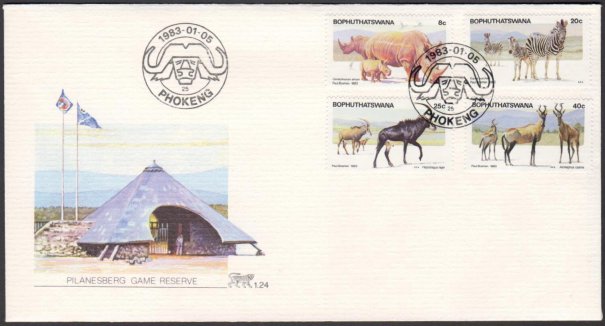 First Day Cover
First Day Cover
|
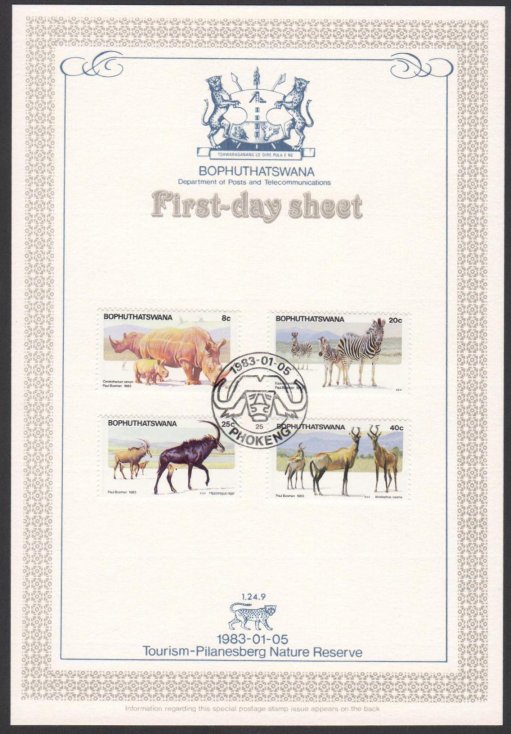 Collectors Sheet
Collectors Sheet
|
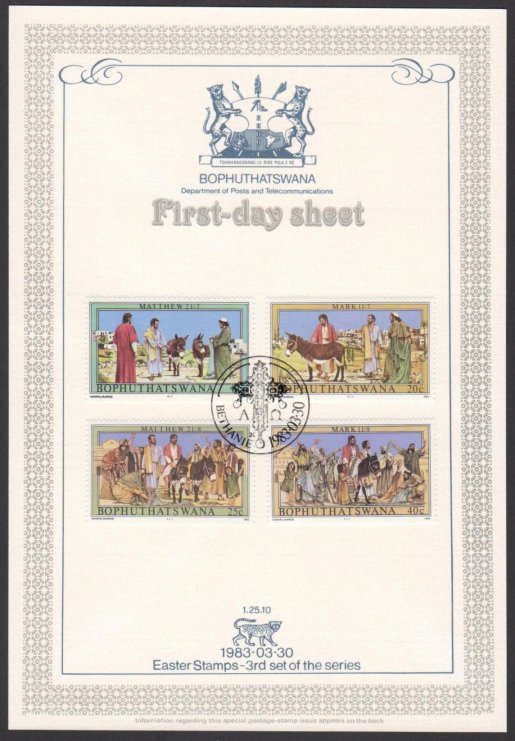 Collectors Sheet
Collectors Sheet
|
| 30
March 1983 - Easter Stamps (3rd Series) |
| Artist/Designer
Angus McBride and Sheila nowers |
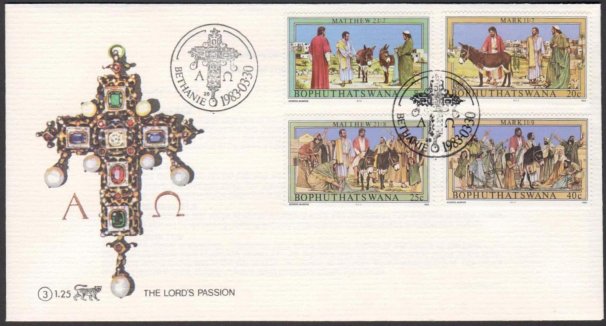 First Day Cover
First Day Cover
|
|
|
22
June 1983
History of the Telephone (3rd Series) |
| Artist/Designer
I. Ellithorne |
|
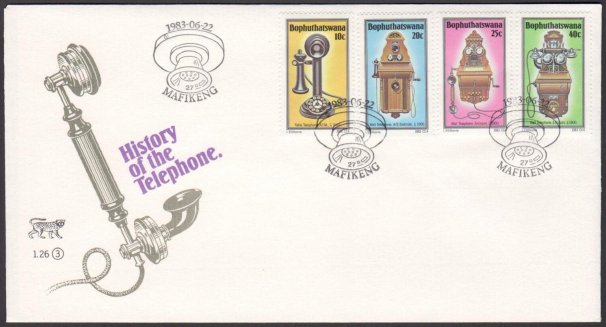 First
Day Cover First
Day Cover |
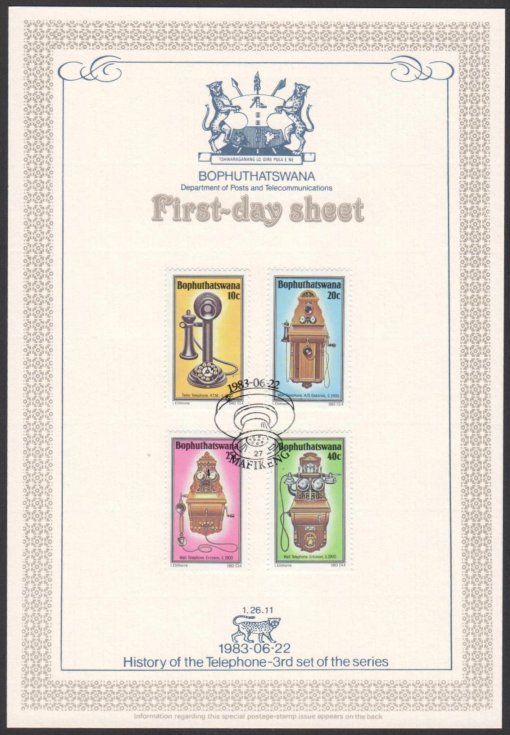 Collectors Sheet
Collectors Sheet
|
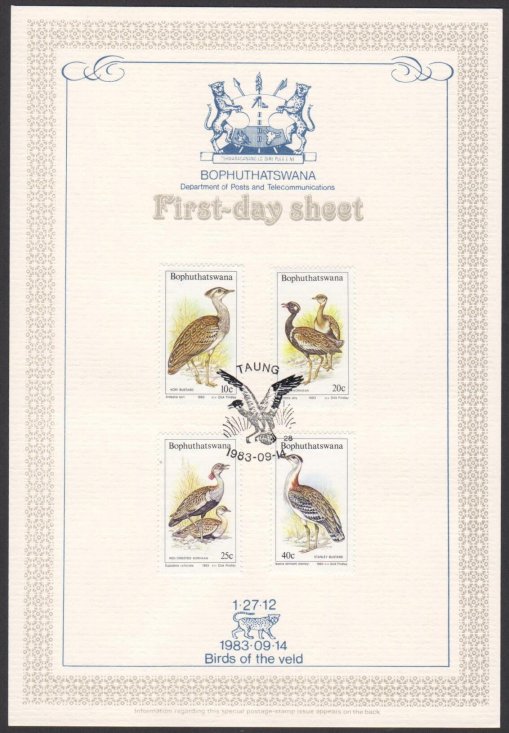 Collectors Sheet
Collectors Sheet
|
| Maximum
Cards
1983 - Telephone History (3rd Series)
This
was the first issue which featured Maximum Cards
1985 Mafeking Maxi cards No’s 17.1 & 17.2
adds two cards to the total (103)
|
Each
card has a number on the reverese
Highest No 101 (1992 Acacia Trees)
From No’s 1 to 56 their size is 147 x 104 mm
From No’s 57 to 101 the size is reduced to 142
x 95 mm |
| |
|
1983
Telephone
History
(3rd Series)
Maximum Cards
No 1 - 4 |
|
|
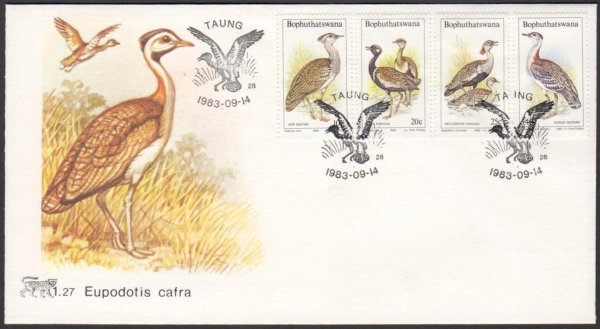 First Day Cover
First Day Cover
|
|
14
September 1983
Veld Birds |
| Artist/Designer
Dick Findlay |
|
|
20
January 1984
Indigenous Grasses (2nd Series)
|
| Artist/Designer
Dick Findlay |
|
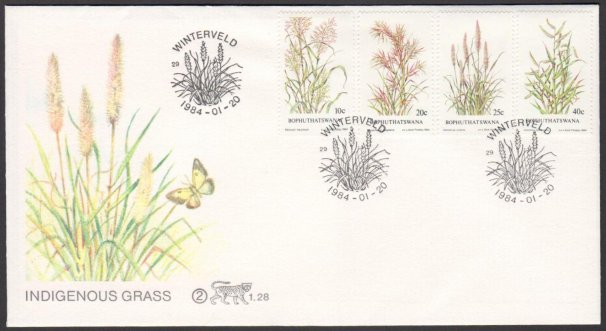 First Day Cover
First Day Cover
|
| |
|
1984
Grasses
Maximum Cards
No 5 - 8
|
|
|
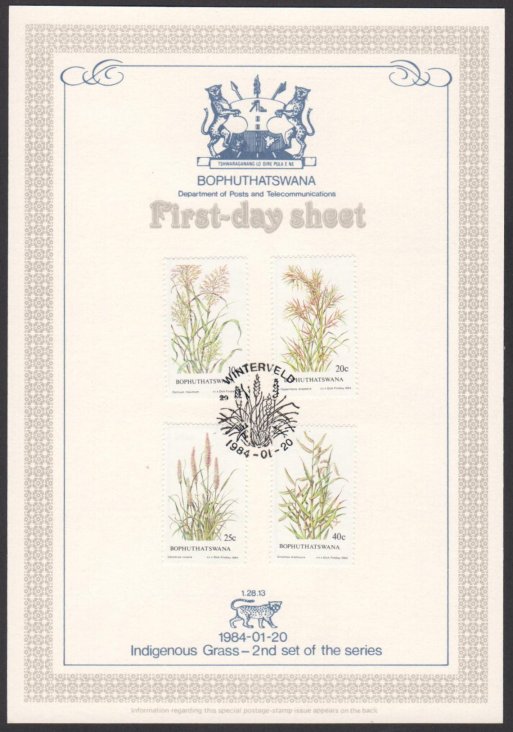 Collectors Sheet
Collectors Sheet
|
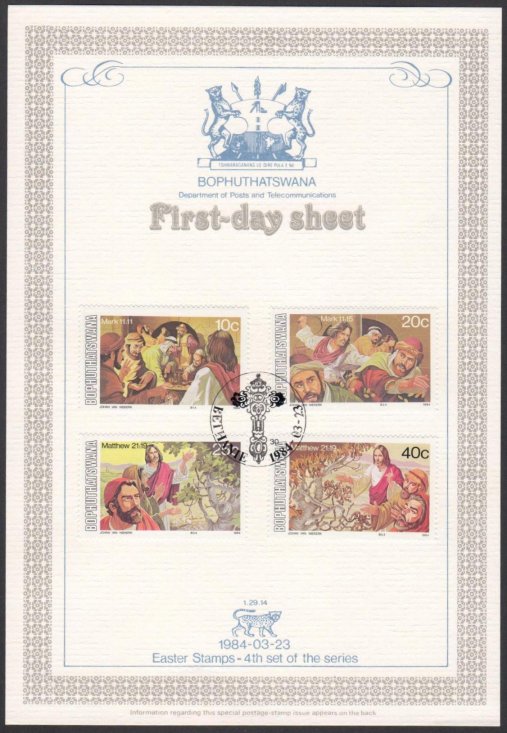 Collectors Sheet
Collectors Sheet
|
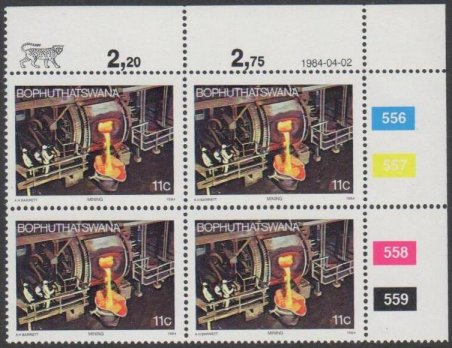 2 April 1984 - 11c New Value
2 April 1984 - 11c New Value
Artist/Designer
A.H. Barrnett |
|
| 23
March 1984 - Easter Stamps (4th Series) |
| Artist/Designer
Johan van Niekerk |
 First Day Cover
First Day Cover
|
|
|
20
July 1984
History of the Telephone(4th Series) |
| Artist/Designer
I. Ellithorne |
|
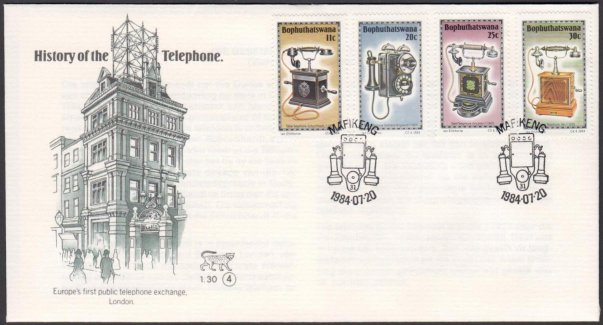 First Day Cover
First Day Cover
|
| |
|
1984
Telephone
History
(4th Series)
Maximum Cards
No 10 - 13 |
|
|
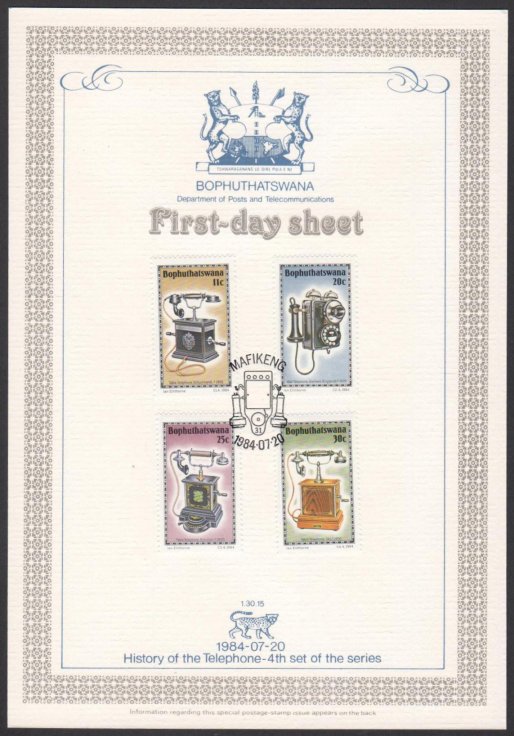 Collectors Sheet
Collectors Sheet
|
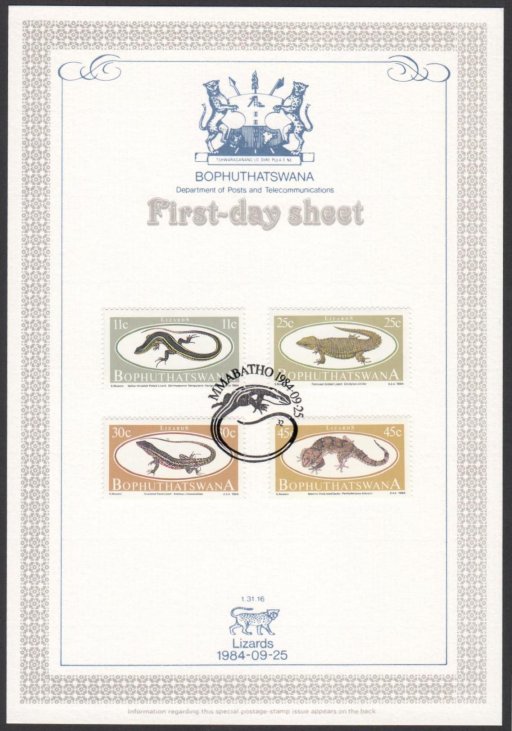 Collectors Sheet
Collectors Sheet
|
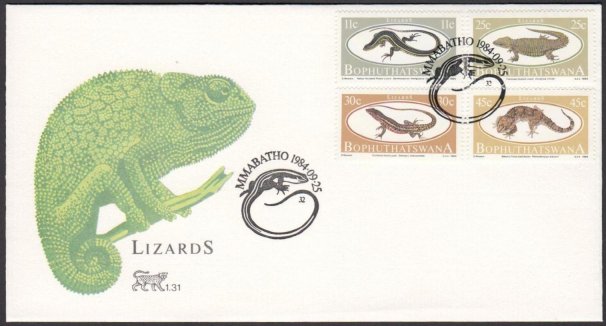 First Day Cover
First Day Cover
|
| 25
September 1984
Lizards |
| Artist/Designer
Sheila Nowers |
|
| |
| 25
January 1985
Health Care
Artist/Designer David C. Thorpe |
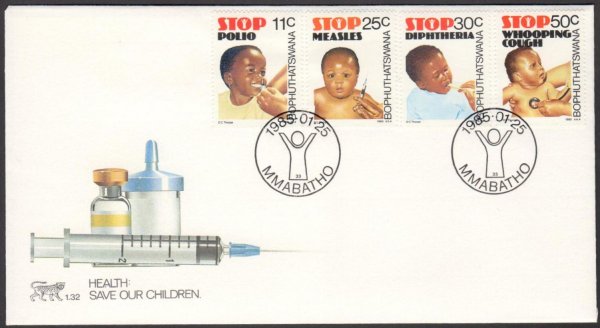 First Day Cover
First Day Cover |
| |
|
1985
Health Care
Maximum Cards
No 14 - 17
|
|
|
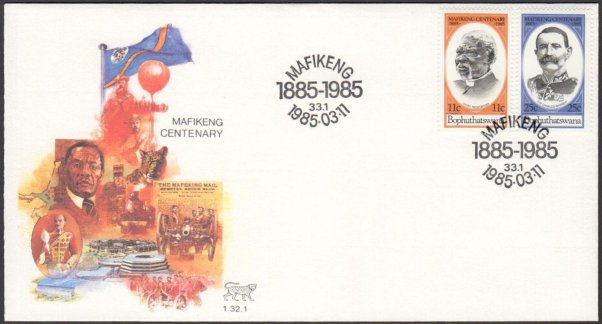
First Day Cover
|
| 11
March 1985
Mafeking Centenary |
| Artist/Designer
A.H. Barrnett |
|
|
|
|
1985
Mafeking
Centenary
Cylinder blocks
Maximum Cards
No 17.1 - 17.2 |
|
|
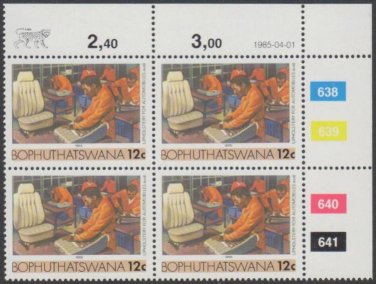 1 April 1984 - 12c New Value
Artist/Designer
A.H. Barrnett
1 April 1984 - 12c New Value
Artist/Designer
A.H. Barrnett |
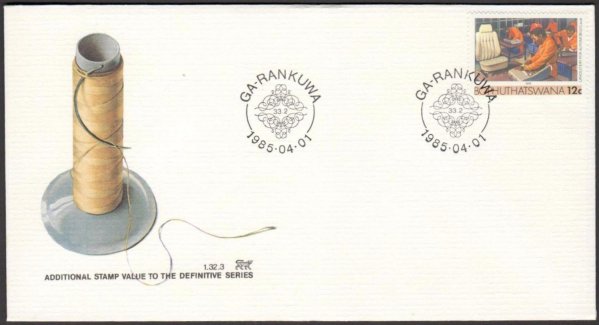 First Day Cover
First Day Cover
|
| 2
April 1985 - Easter Stamps (5th Series) |
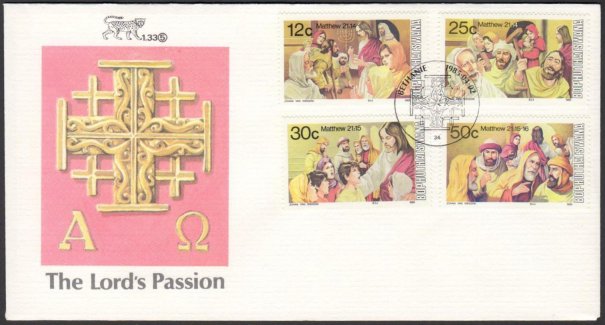 First Day Cover
First Day Cover |
| Artist/Designer
Johan van Niekerk |
|
| |
|
1985
Easter
Maximum Cards
No 18 - 20 |
|
|
| Artist/Designer
Barry Jackson |
|
4 July
1985
Tree Conservation
|
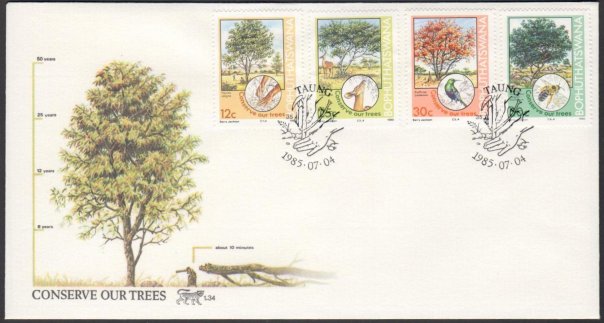 First Day Cover
First Day Cover |
|
|
| 25
October 1985 - Bophuthatswana Industries - Second
Definitives |
| |
.jpg)
2 April 1984 - New Value |
.jpg)
1 April 1985 - New Value |
.jpg)
1 April 1986 - New Value |
| |
.jpg) 1 April
1987 - New Value
1 April
1987 - New Value |
.jpg) 3 July
1989 - New Value
3 July
1989 - New Value |
|
|
 3 August 1990
- 21c Additional Value - Bus Assembly
3 August 1990
- 21c Additional Value - Bus Assembly |
| Artist/Designer
Johan van Niekerk |
|
| 6
March 1986 - Easter Stamps (6th Series) |
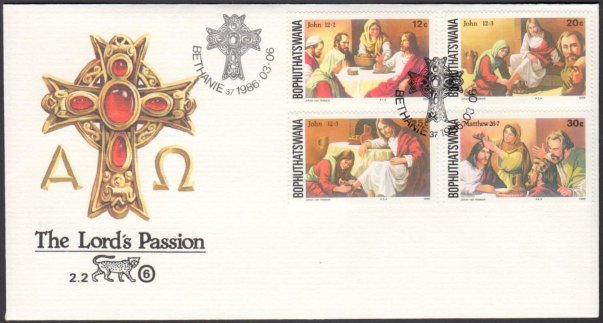 First Day Cover
First Day Cover |
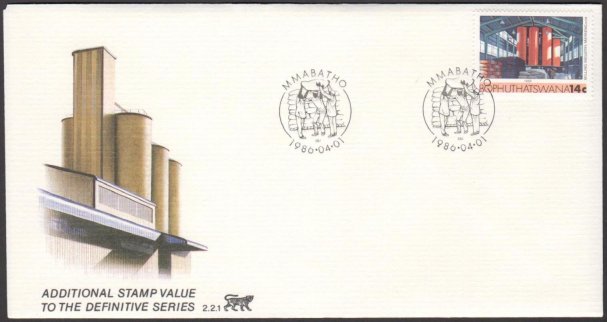 First Day Cover
First Day Cover
|
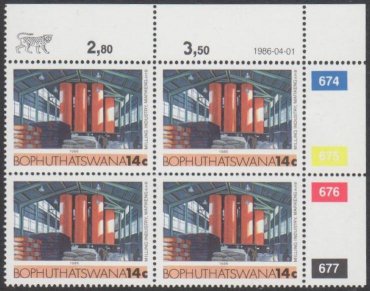 1 April 1986 - 14c New Value
Artist/Designer
A.H. Barrnett
1 April 1986 - 14c New Value
Artist/Designer
A.H. Barrnett |
| 15
May 1986
Historic Thaba ‘Nchu
|
|
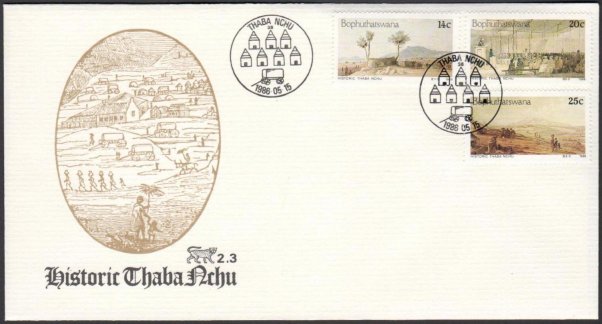 First Day Cover
First Day Cover |
|
|
|
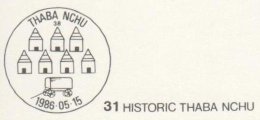 Cancellation depicted on
Cancellation depicted on
the back of Maxi card |
|
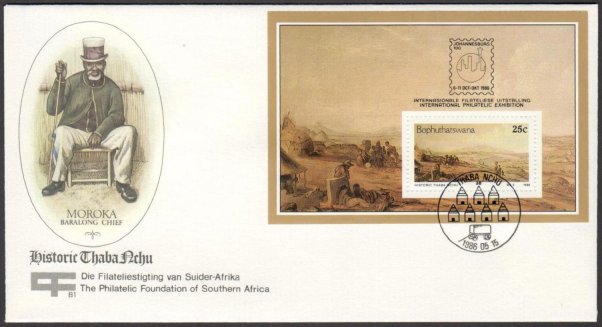 1986 Foundation MS
FDC
1986 Foundation MS
FDC |
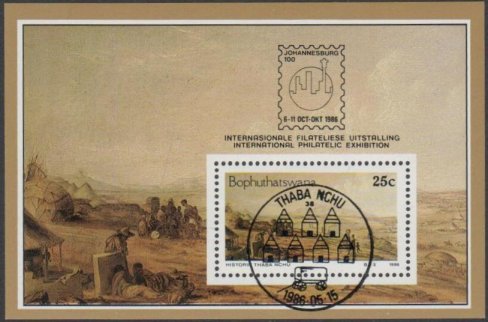 1986 Philatelic Foundation
MS No 1
1986 Philatelic Foundation
MS No 1 |
| 6
August 1986 - Temisano Project |
|
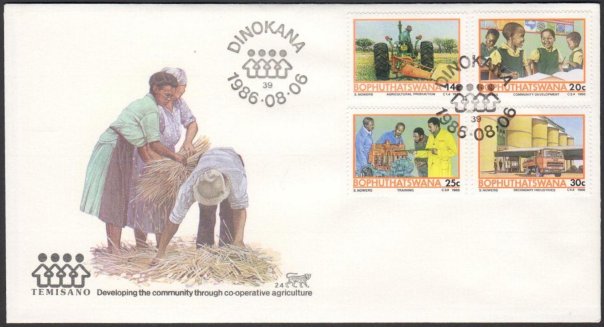 First Day Cover
First Day Cover |
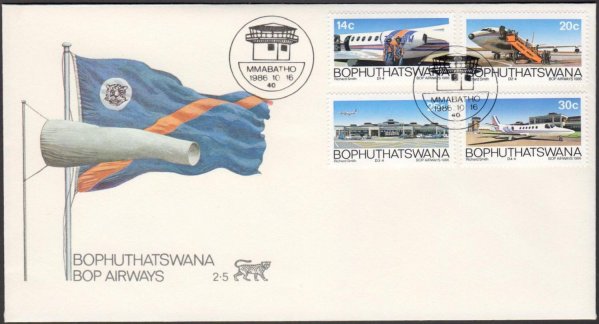 First Day Cover
First Day Cover |
| 16
October 1986
BOP Airways |
| Artist/Designer
Richard Smith |
|
|
|
Artist/Designer
Barry Jackson |
|
|
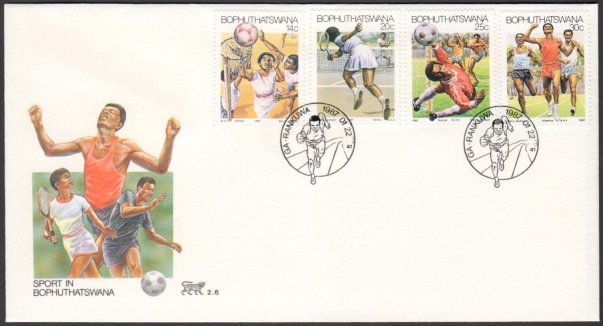 First Day Cover
First Day Cover |
|
|
|
Commemorative
Cancels
Used on
Sports Issue |
|
|
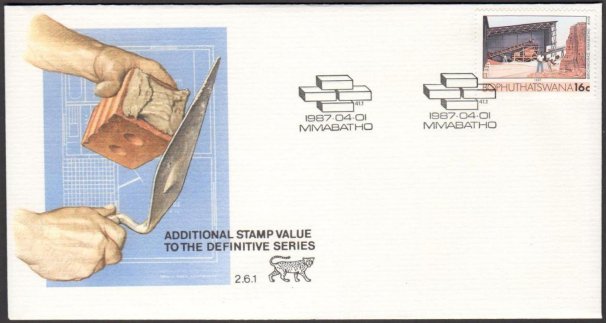 First Day Cover
First Day Cover
|
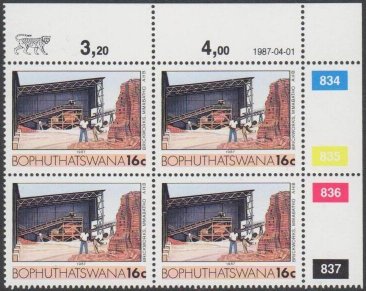 1 April 1987 - 16c New Value
1 April 1987 - 16c New Value
Artist/Designer
A.H. Barrnett
|
|
|
23
April 1987
Wild Flowers |
|
|
|
Artist/Designer
Jeanette Stead |
|
|
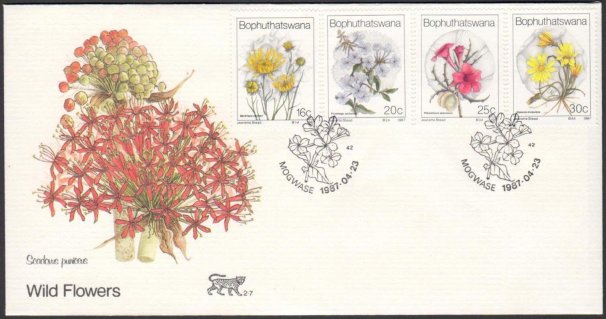 First Day Cover
First Day Cover |
 1987 Foundation MS FDC
1987 Foundation MS FDC
|
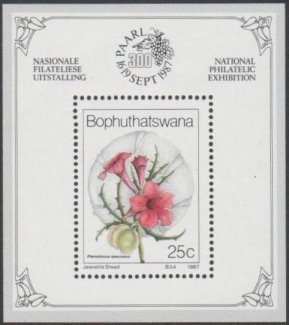 1987 Foundation MS No 2
1987 Foundation MS No 2 |
| Artist/Designer
Mike Dias |
|
| 6
August 1987 - Places of Tertiary Education |
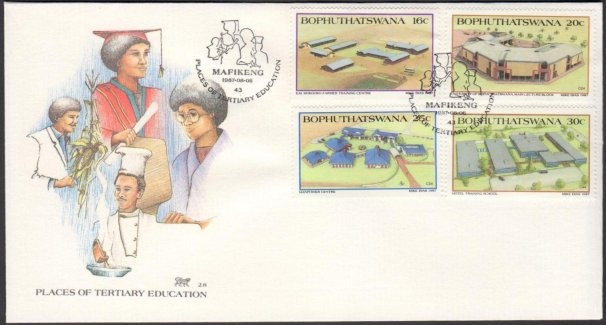 First Day Cover
First Day Cover |
|
Commemorative
Cancels used
on each Maxi card |
| 4
December 1987 - 10th Anniversary of Independence |
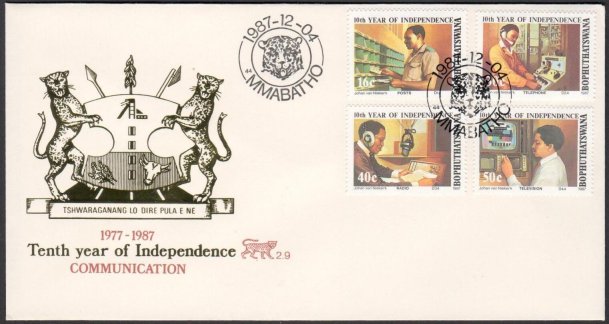 First Day Cover
First Day Cover |
| Artist/Designer
Johan van Niekerk |
|
|
|
|
1987
Independence
Anniversary
Maximum Cards
No 53 - 56 |
|
|
| Commemorative
Cancels used
on each Maxi card |
| 31
March 1988 - Easter Stamps (7th Series) |
| Artist/Designer
Johan van Niekerk |
|
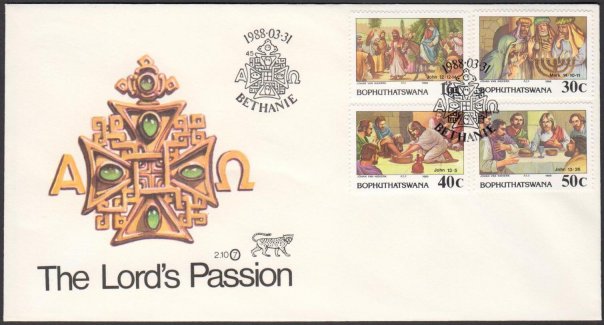 First Day Cover
First Day Cover |
| 22
June 1988 - National Parks Board |
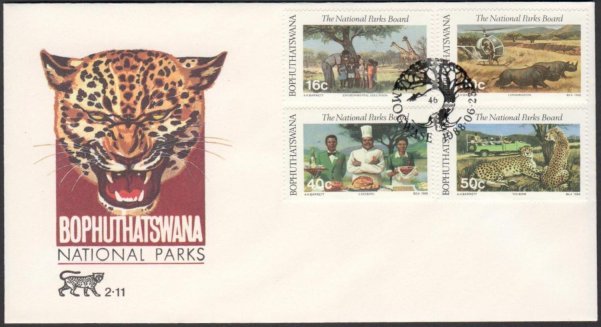 First Day Cover
First Day Cover |
| Artist/Designer
A.H. Barrnett |
|
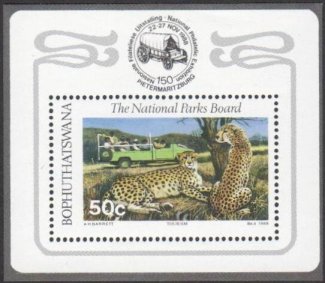 1988 Foundation MS No 3
1988 Foundation MS No 3 |
 1988 Foundation MS FDC
1988 Foundation MS FDC
|
| 15
September 1988 - Agricultural Crops |
 First Day Cover
First Day Cover |
| Artist/Designer
A.H. Barrnett
|
|
| Artist/Designer
Estelle Marais |
|
| 17
November 1988 - Water Conservation |
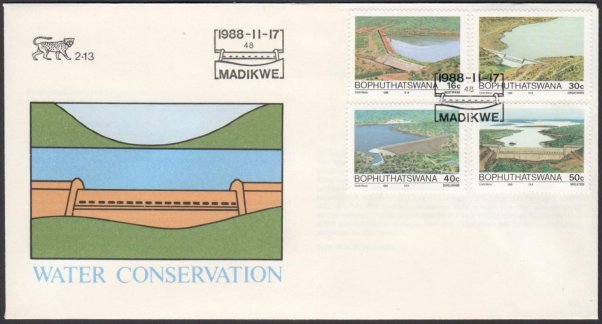 First Day Cover
First Day Cover |
| |
4
April 1989
The Sun City Express
Commemorative cover and cancellation (S30)
The train speeds twice
a week between Johannesburg,
Pretoria and Sun City, leaving on Saturdays and all
public holidays at 0830
and returning at 2300, and on Sundays at 0830 returning
2100
Getting to Sun City by Express means arriving fresh
and alive, having breakfasted in Continental or English
style at one of the three sittings,
and stretched out in one of the aeroplane-design,
tilted transit seats
There are three kinds of accommodation: suburban,
transit and sleeper,
as well as a dining car, lounge and bar car |
| 9
March 1989 - Easter Stamps (8th Series) |
| Artist/Designer
Johan van Niekerk |
|
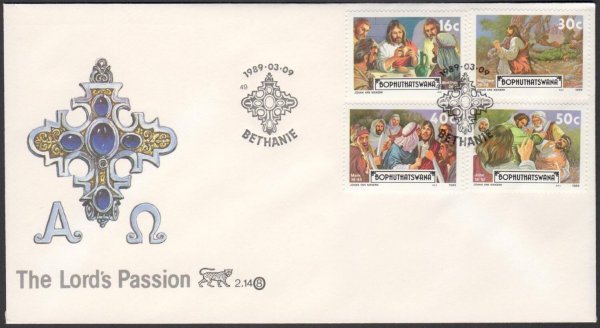 First Day Cover
First Day Cover |
| 11
May 1989 - Children’s Art |
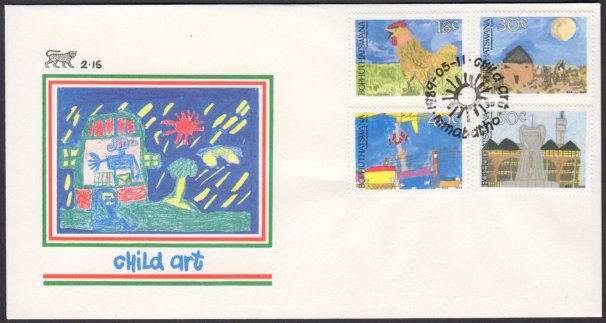 First Day Cover
First Day Cover |
.jpg) Thembi Atong - 13 years old
Thembi Atong - 13 years old
|
.jpg) Muhammed Mahri - 12 years old
Muhammed Mahri - 12 years old
|
.jpg) Tshepo Mashokwe - 10 years old
Tshepo Mashokwe - 10 years old
|
.jpg) Miles Brown - 13 years old
Miles Brown - 13 years old
|
|
 3 July 1989 - 18c New Value
Artist/Designer
A.H. Barrnett
3 July 1989 - 18c New Value
Artist/Designer
A.H. Barrnett |
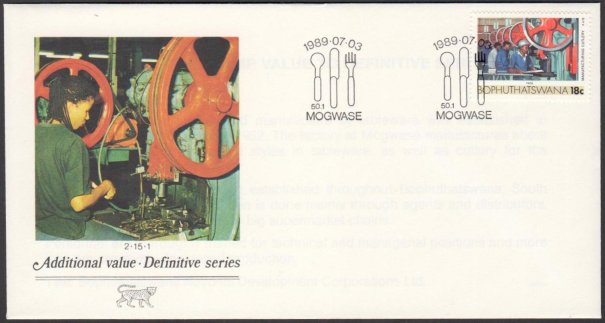 First Day Cover
First Day Cover |
Artist/Designer
C.G. Davies
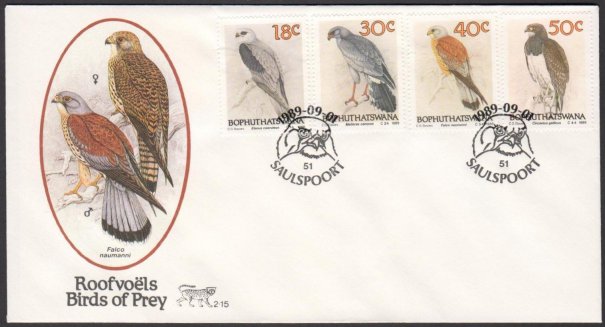 First Day Cover
First Day Cover |
|
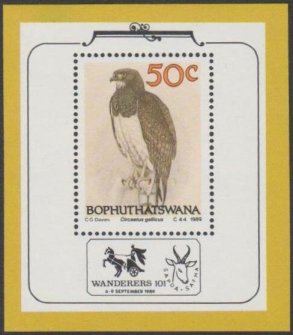 1989 Foundation MS No 4
1989 Foundation MS No 4 |
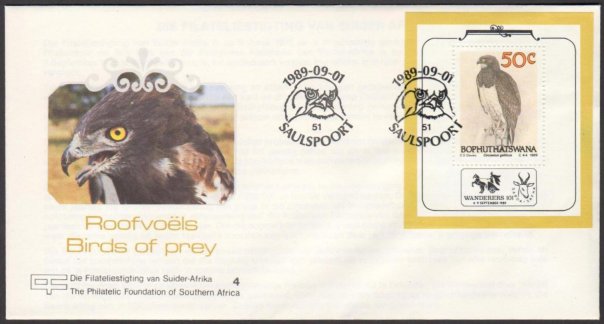
1989 Foundation MS FDC |
Artist/Designer
A.D. George
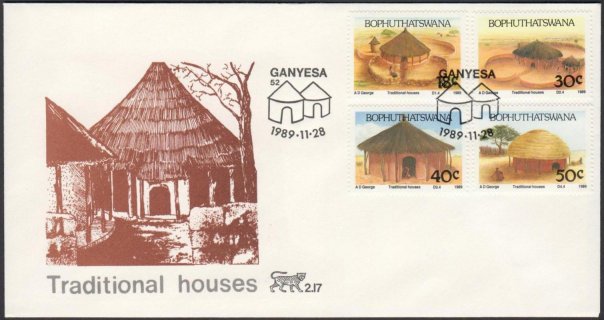 First Day Cover
First Day Cover |
| 28
Novemer 1989 - Traditional Houses |
|
| 1
January 1990 - Community Services |
|
Artist/Designer
D. Mc Lean
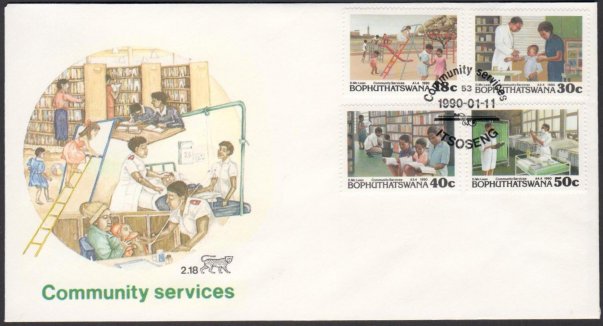 First Day Cover
First Day Cover |
Artist/Designer
Alan Ainlie
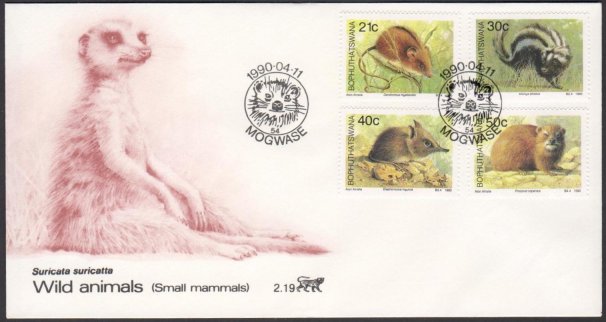 First Day Cover
First Day Cover |
| 11
April 1990 - Small Mammals |
|
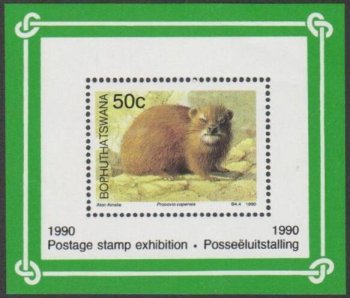 1990 Foundation MS No 5
1990 Foundation MS No 5 |
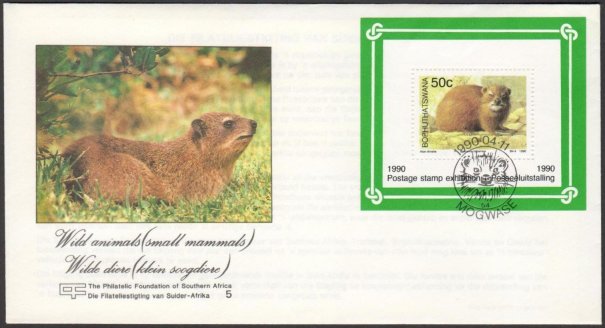 1990 Foundation MS FDC
1990 Foundation MS FDC |
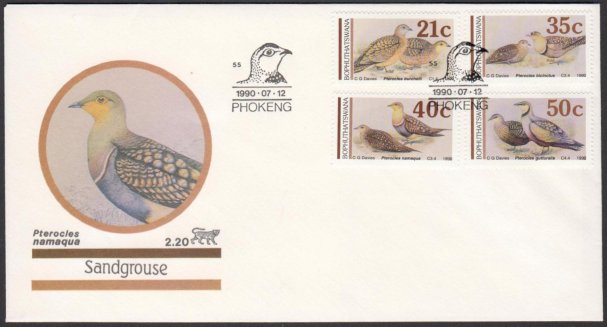 First Day Cover
First Day Cover |
| 12
July 1990 - Sand Grouse |
| Artist/Designer
C.G. Davies |
|
| 3
August 1990
Added 21c Value
Bus Industry |
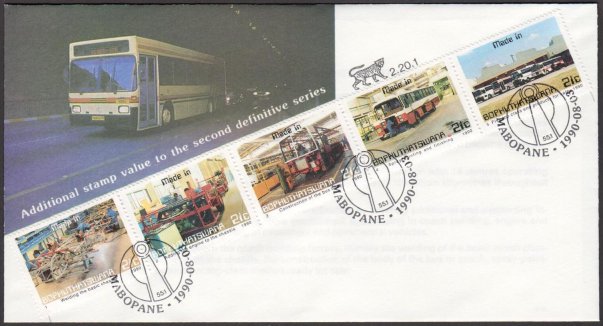 First Day Cover
First Day Cover
|
Artist/Designer
Sheila Nowers
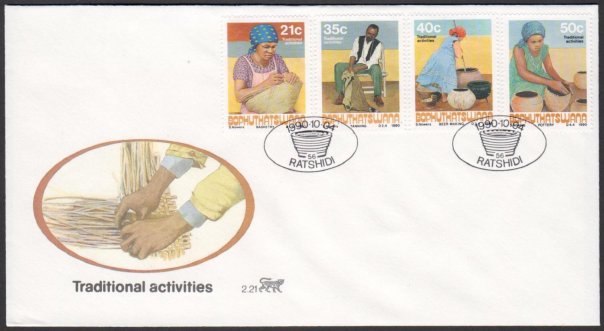 First Day Cover
First Day Cover |
|
12 December 1990
10th Anniversary of
BOP Air Force
|
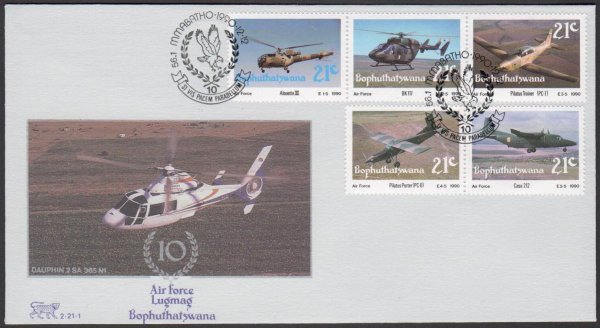 First Day Cover
First Day Cover |
Artist/Designer
Gillian Condy
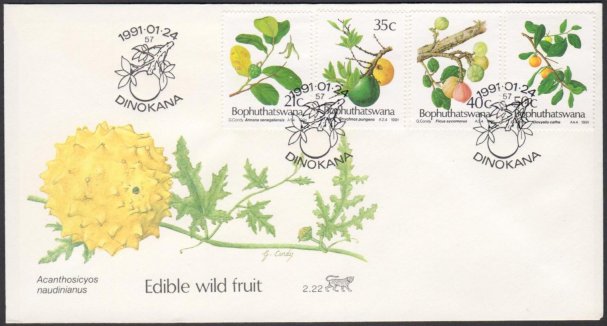 First Day Cover
First Day Cover |
|
| 12
March 1991 - Easter Stamps (9th Series) |
| Artist/Designer
Johan van Niekerk |
|
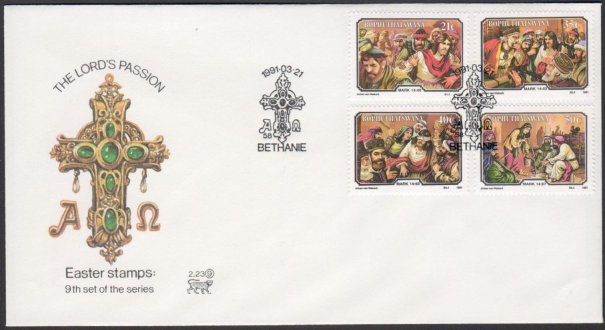 First Day Cover
First Day Cover |
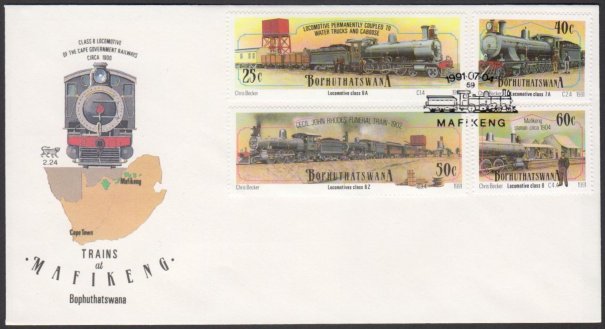 First Day Cover
First Day Cover |
|
|
4
July 1991
Steam Locomotives (1st) |
| Artist/Designer
Chris Becker |
|
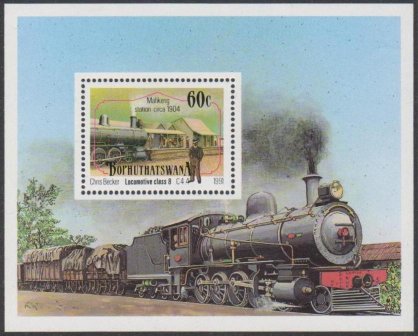
1991 Foundation MS No
6 |
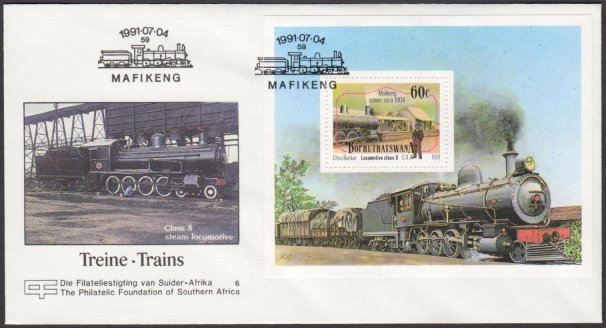 1991 Foundation
MS FDC
1991 Foundation
MS FDC |
| Artists/Designers
Chris Becker (25c & 40c) Theo Marais (50c &
60c)
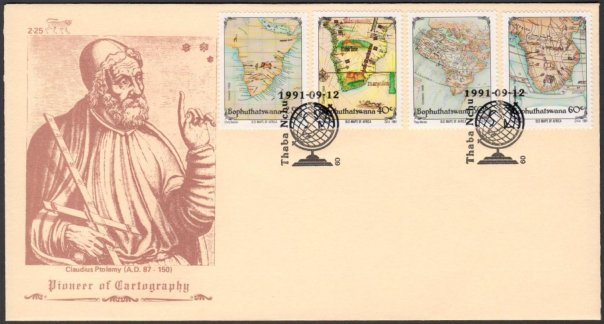 First Day Cover
First Day Cover |
|
|
Old
Maps
of Africa
(1st Series) |
|
|
| 9
January 1992 - Old Maps of Africa (2nd Series) |
|
Artist/Designer
Liza van der Wal
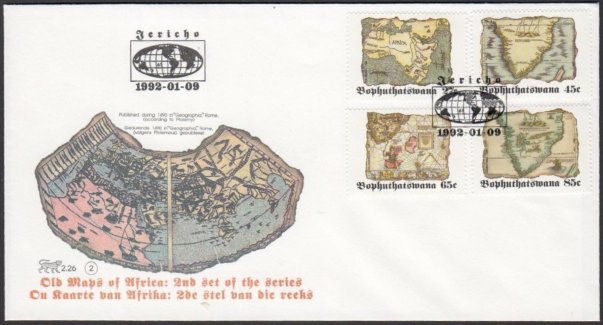 First Day Cover
First Day Cover |
Artist/Designer
Johan van Niekerk
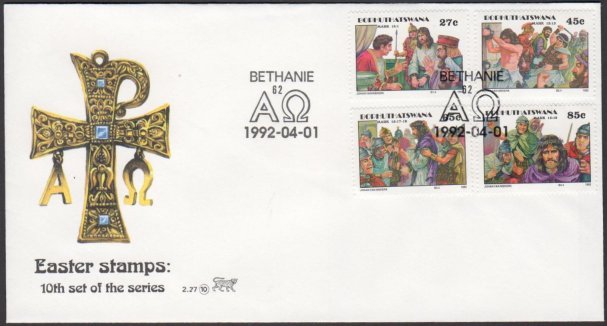 First Day Cover
First Day Cover |
| 1
April 1992 - Easter Stamps (10th Series) |
|
| 18
June 1992 - Acacia Trees |
|
Artist/Designer
Gillian Condy
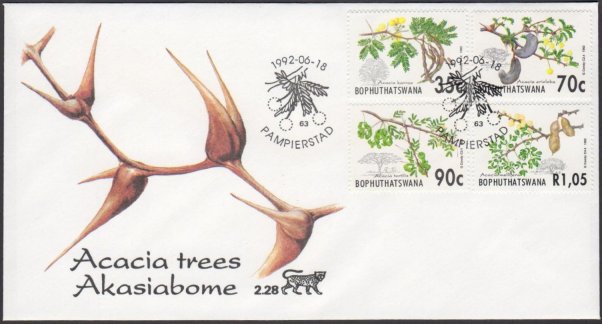 First Day Cover
First Day Cover |
| Maximum
Cards No
98 - 101 |
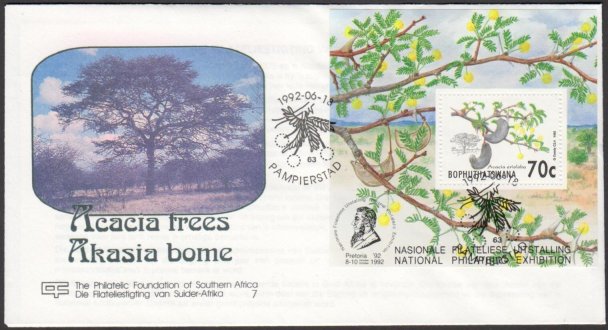 1992 Foundation MS
FDC
1992 Foundation MS
FDC |
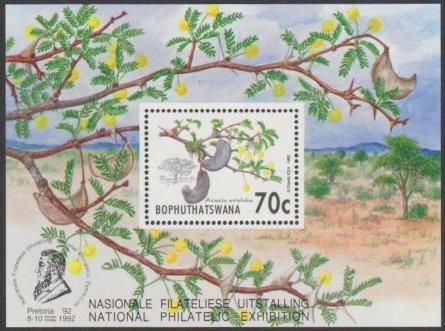 1992 Foundation MS
No 7
1992 Foundation MS
No 7 |
| 19
November 1992
Sun City Complex
(The Lost City) |
|
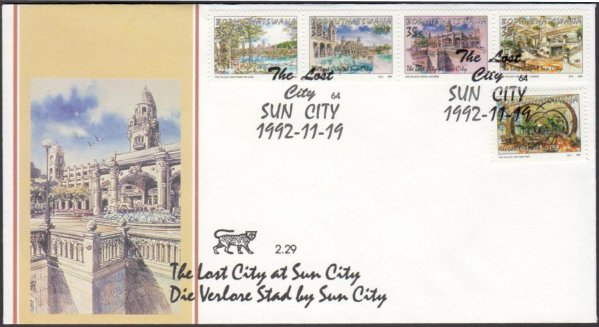
First Day Cover |
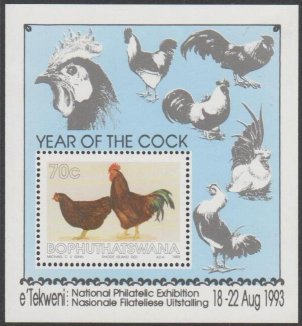 1993 Foundation MS No 8
1993 Foundation MS No 8 |
|
12
February 1993 - Chicken Breeds
|
|
Artist/Designer
Michael C.V. Ginn
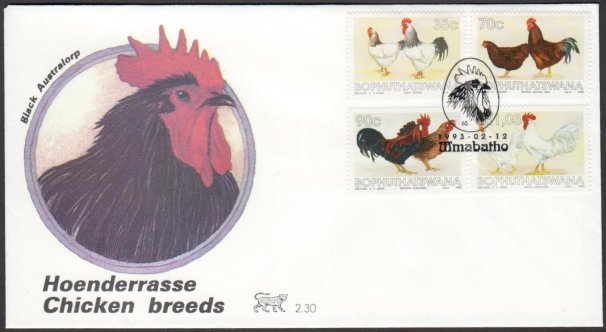 First Day Cover
First Day Cover |
Artist/Designer
Johan van Niekerk
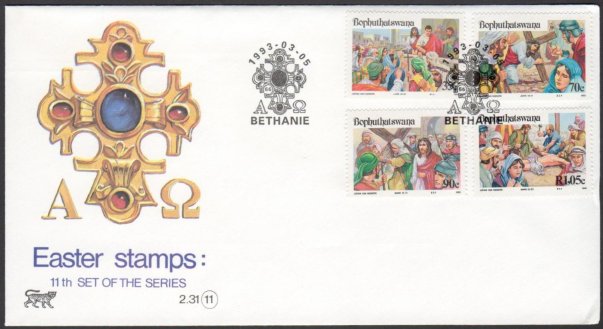 First Day Cover
First Day Cover |
| 5
March 1993 - Easter Stamps (11th Series) |
|
|
18
June 1993
Trains
- Locomotives (2nd) |
|
Artist/Designer
Chris Becker |
|
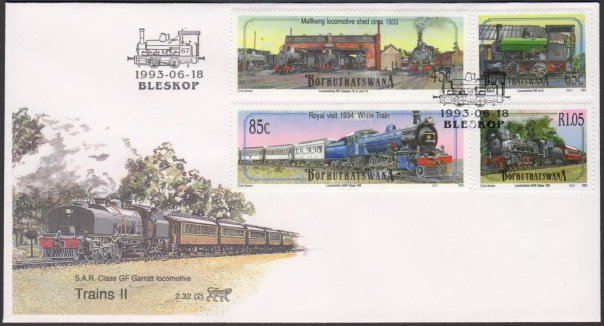 First Day Cover
First Day Cover |
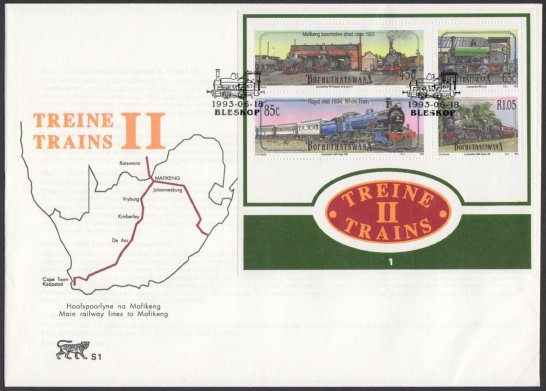
Miniature Sheet SG MS297 |
|
| 20
August 1993 - Old Maps of Africa (3rd Series) |
|
Artist/Designer
C. Prinsloo
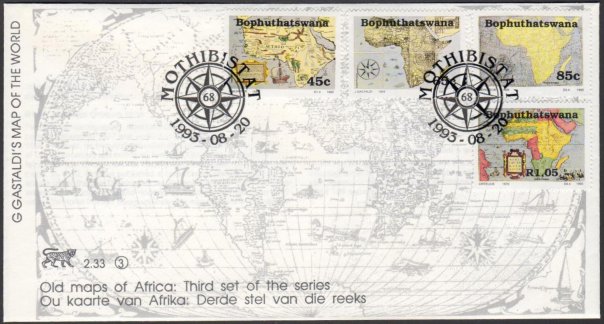 First Day Cover
First Day Cover |
Artist/Designer
Johan van Niekerk
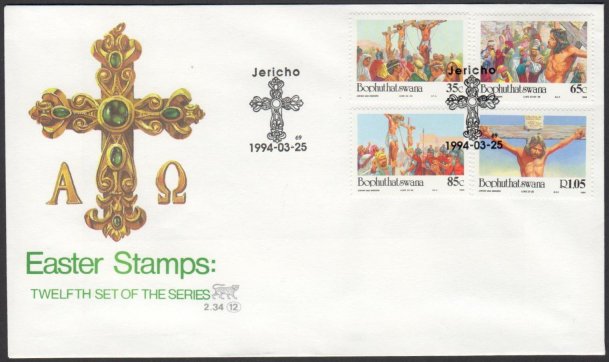 First Day Cover
First Day Cover |
|
25
March 1994 - Easter Stamps (12th Series) |
|
|
|